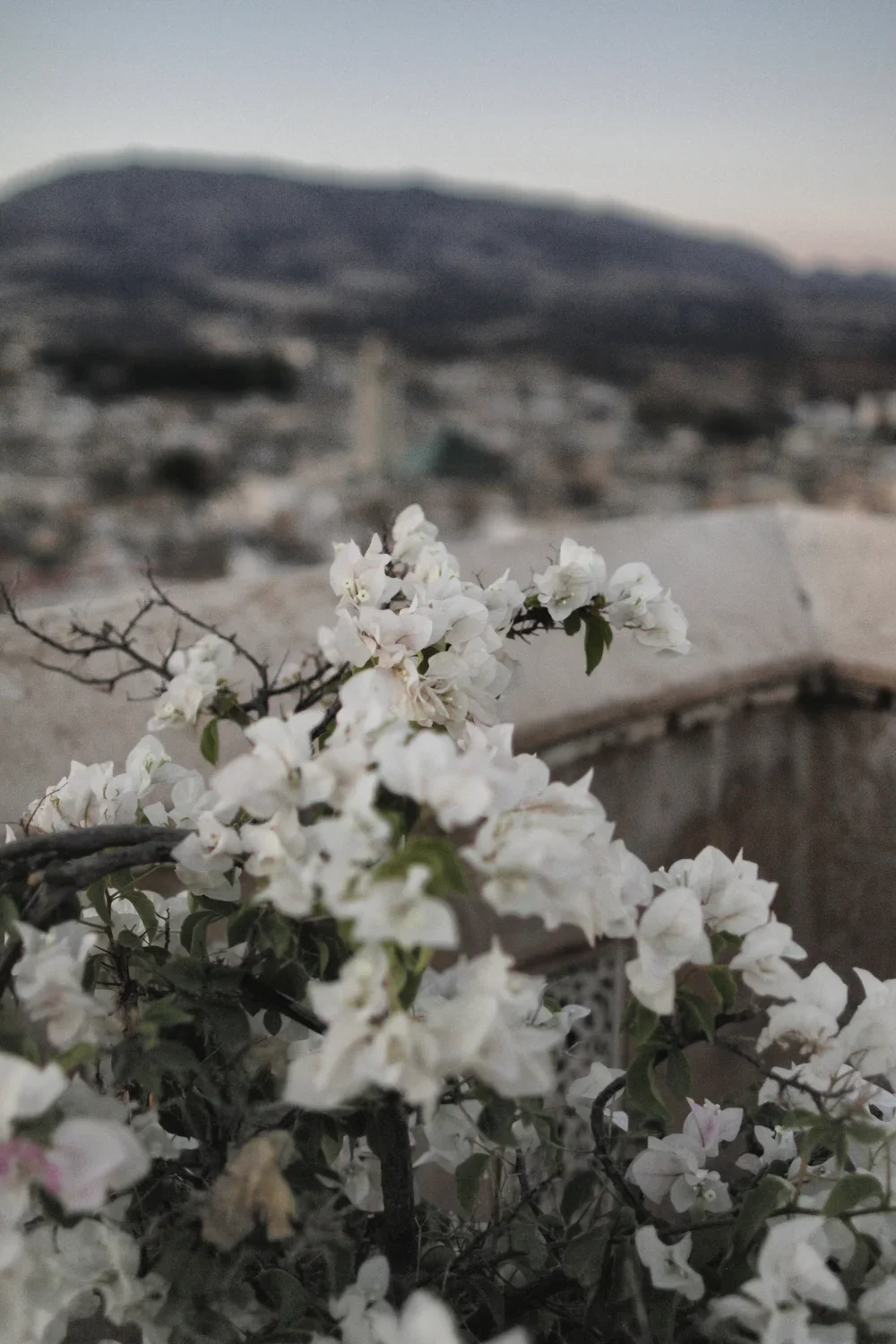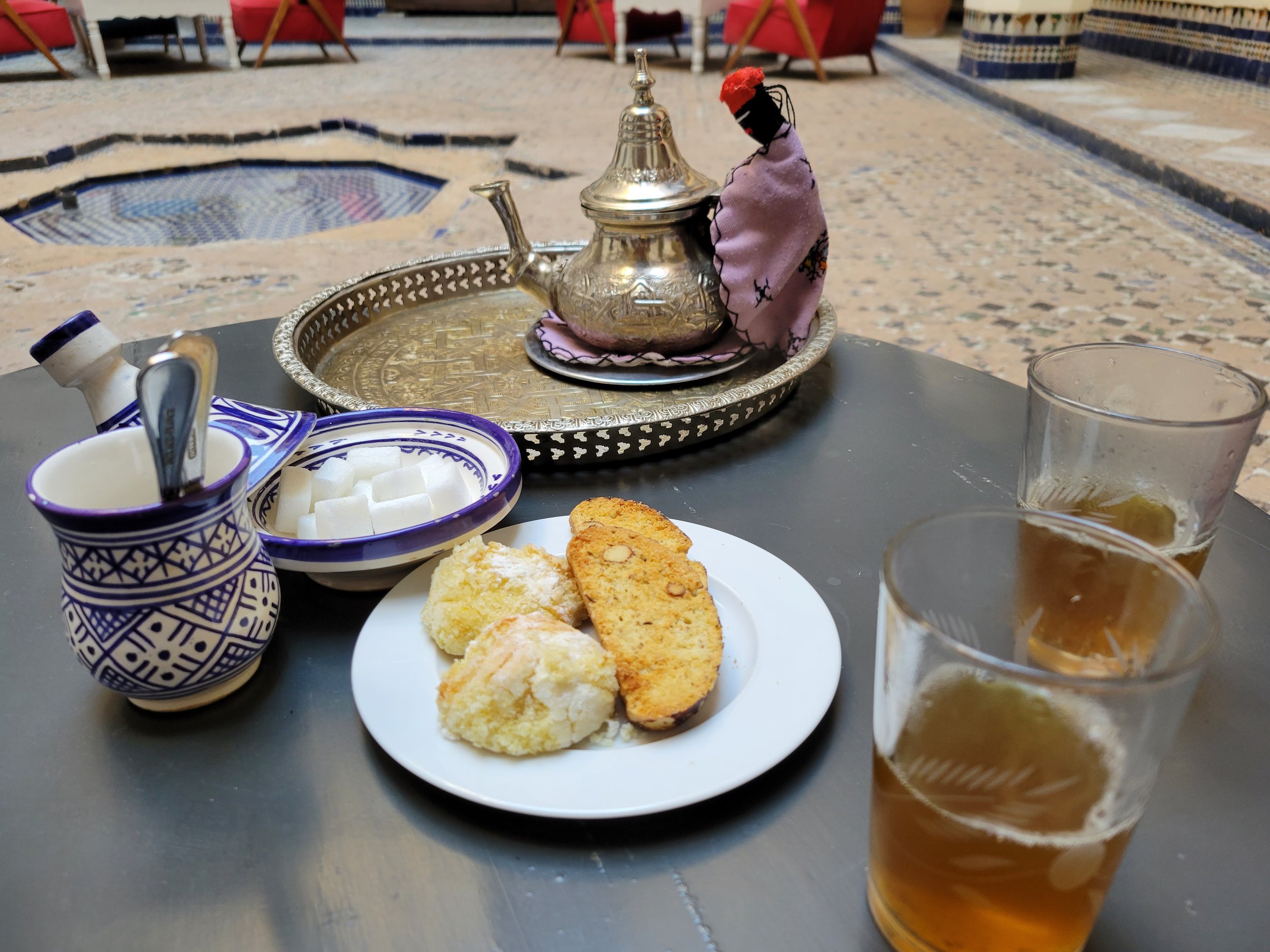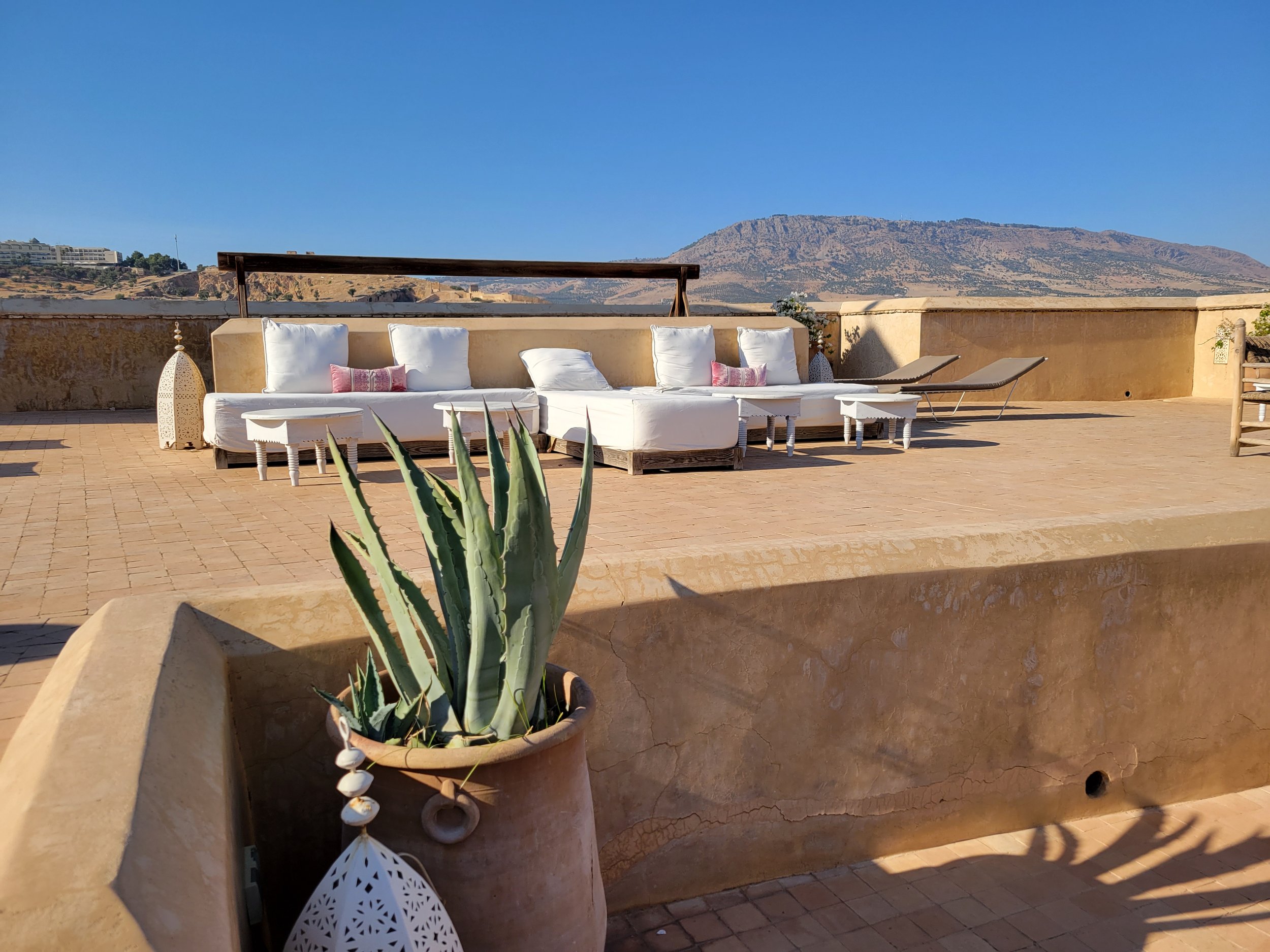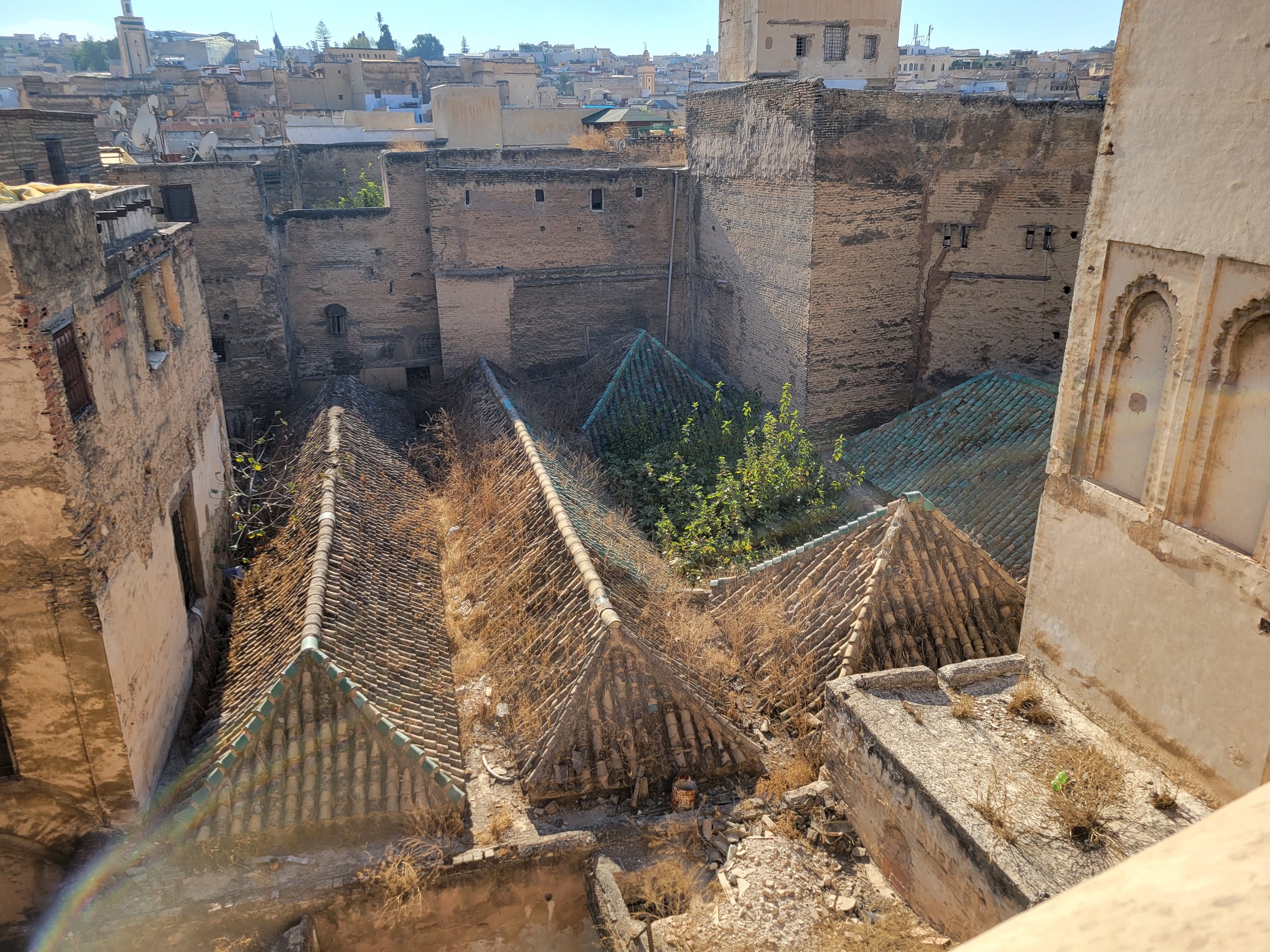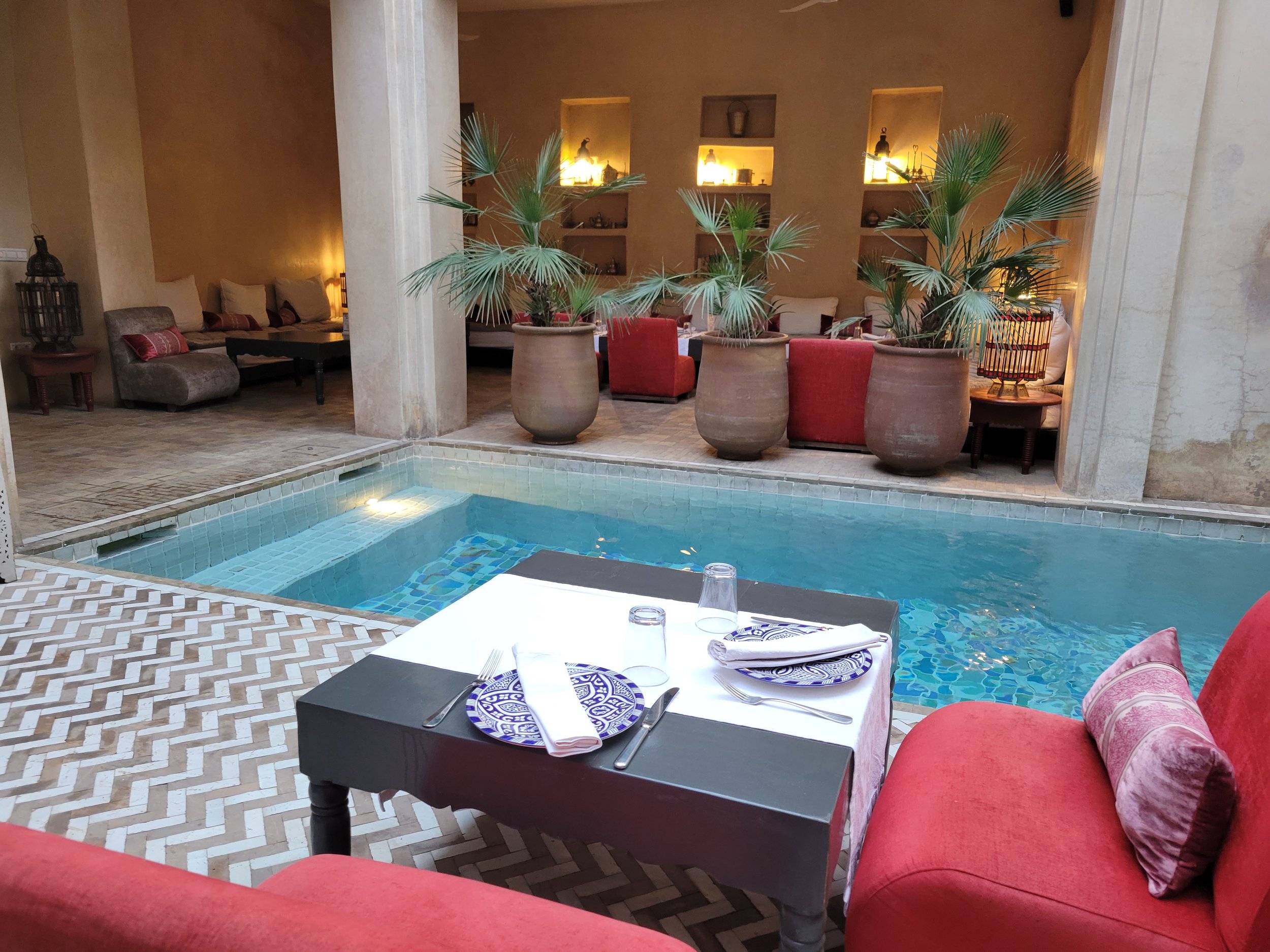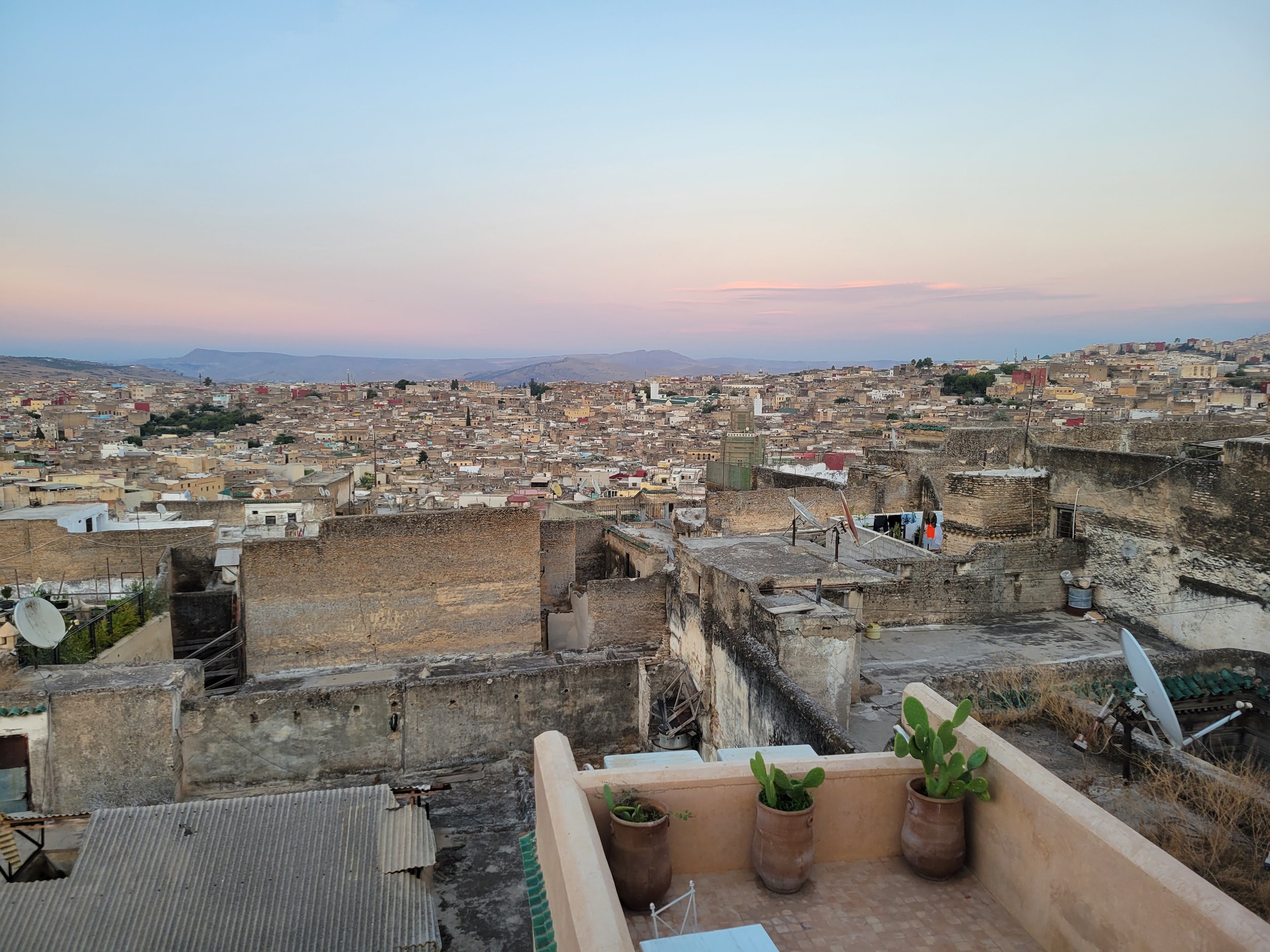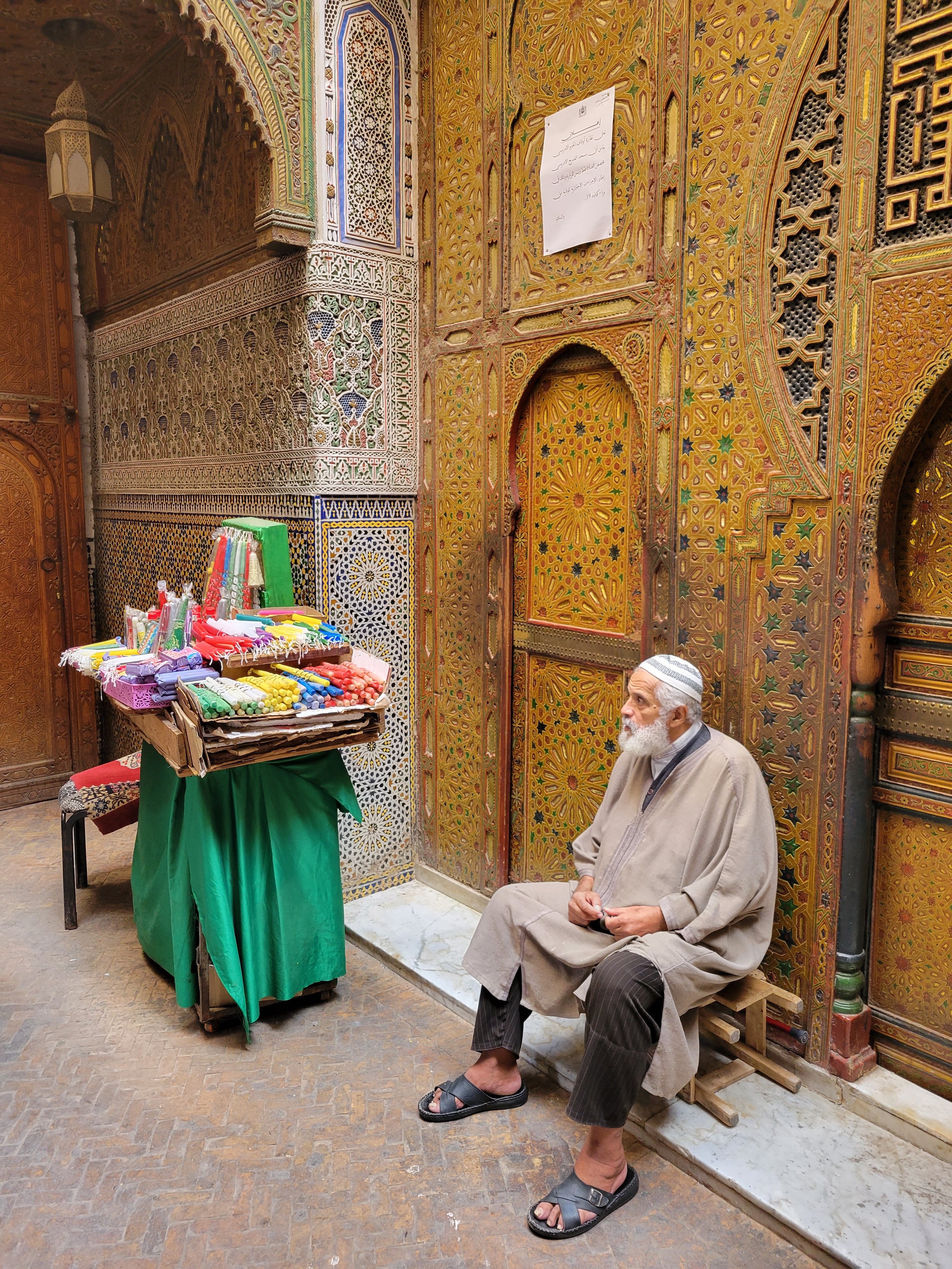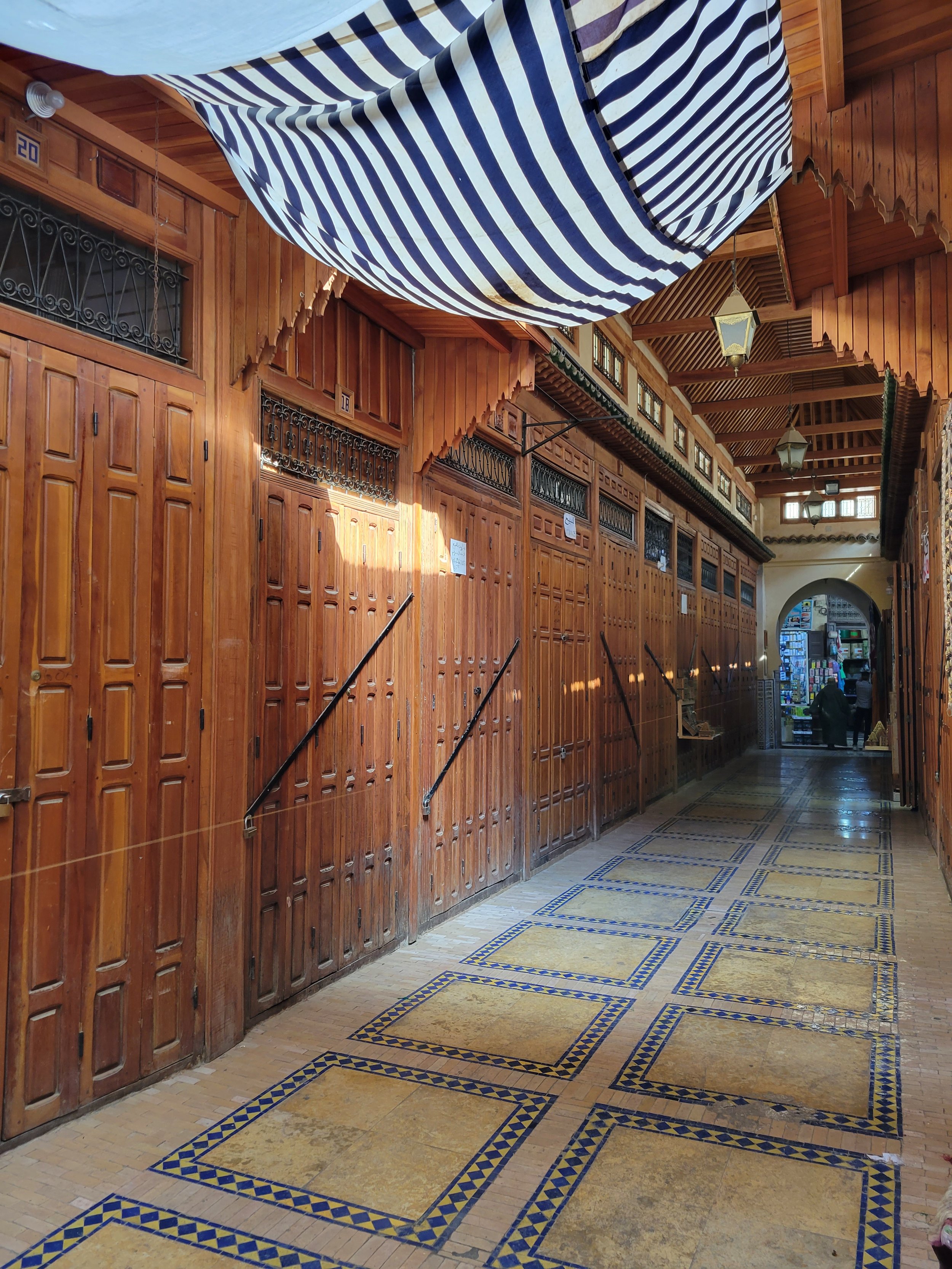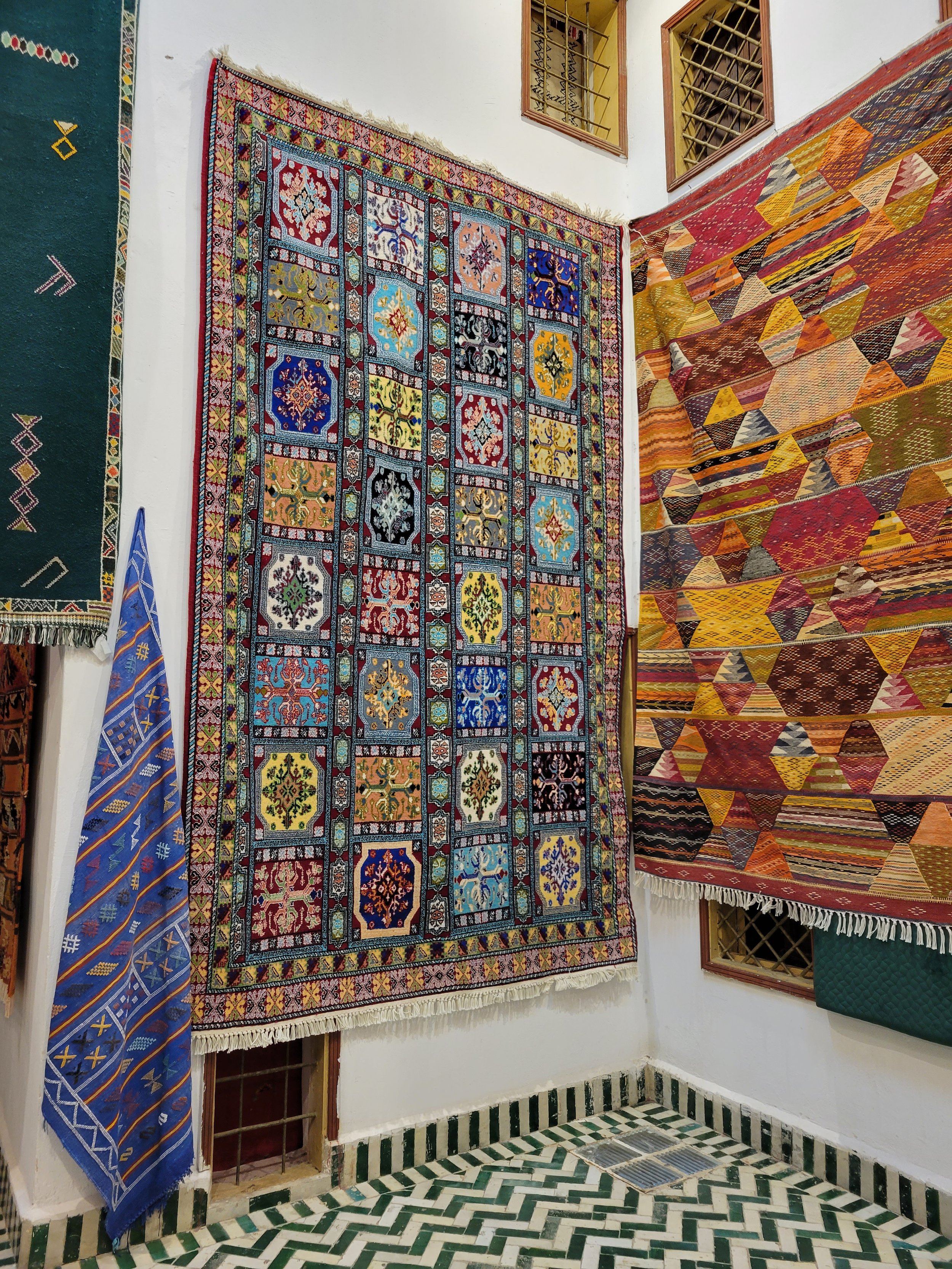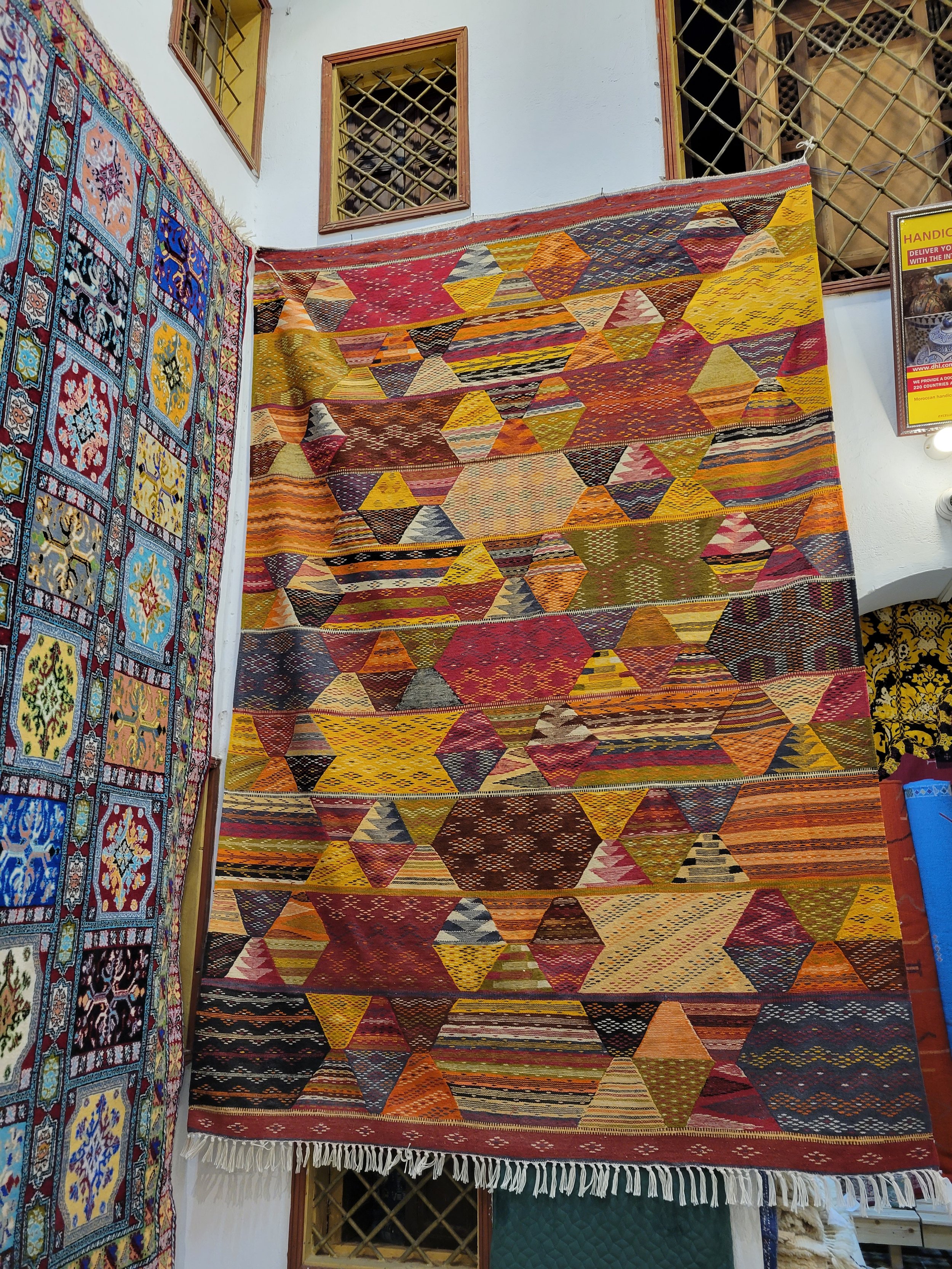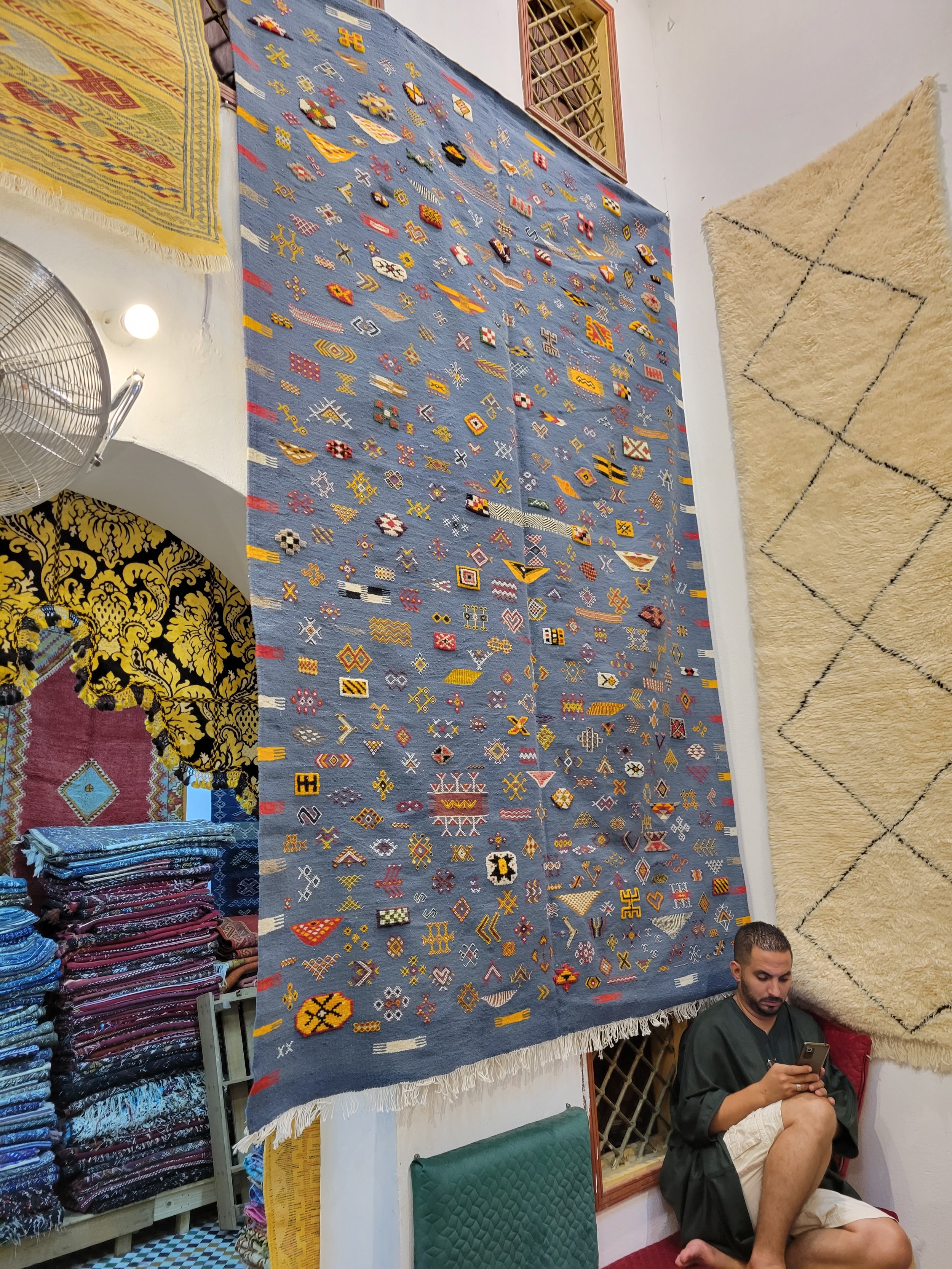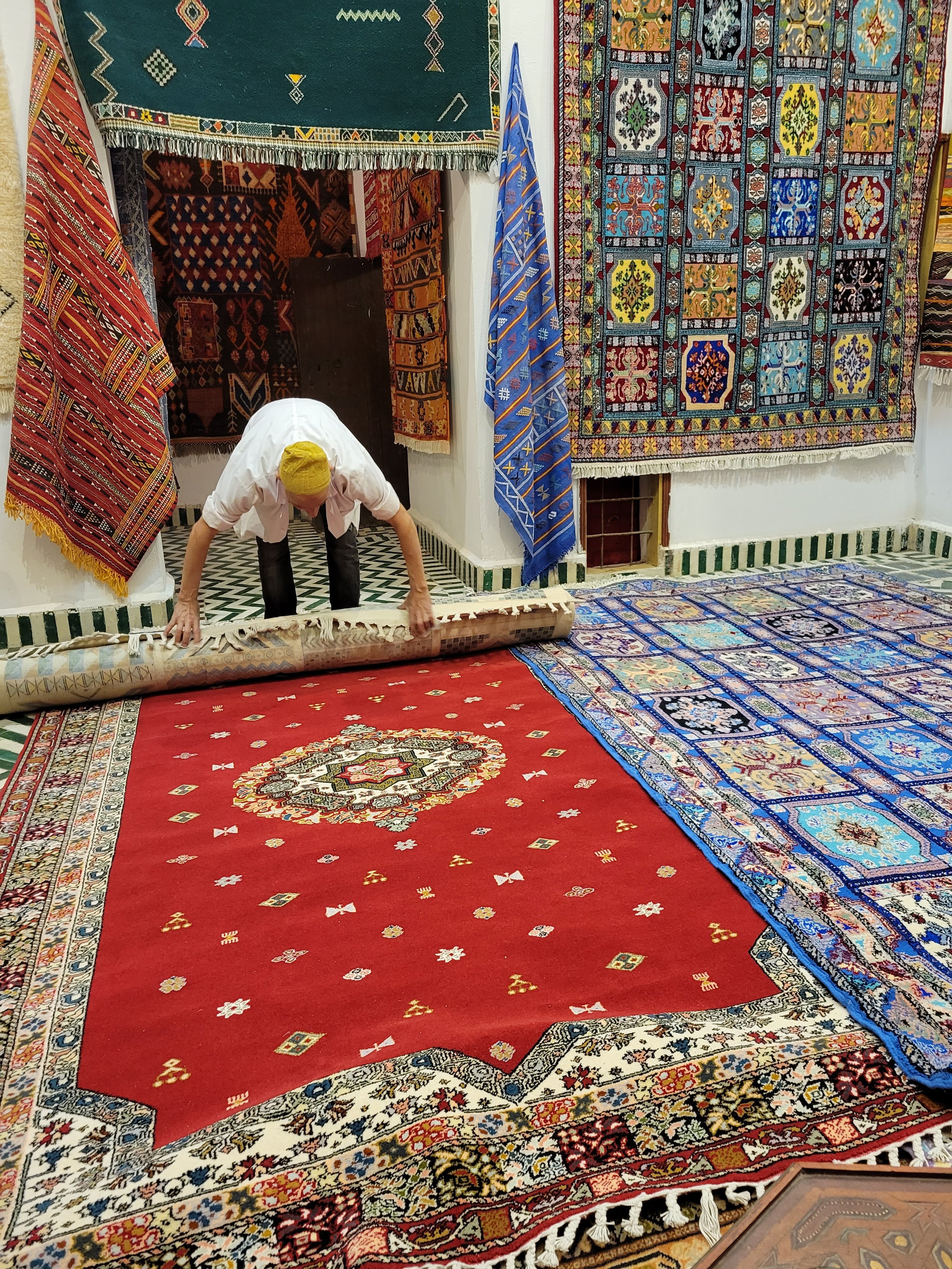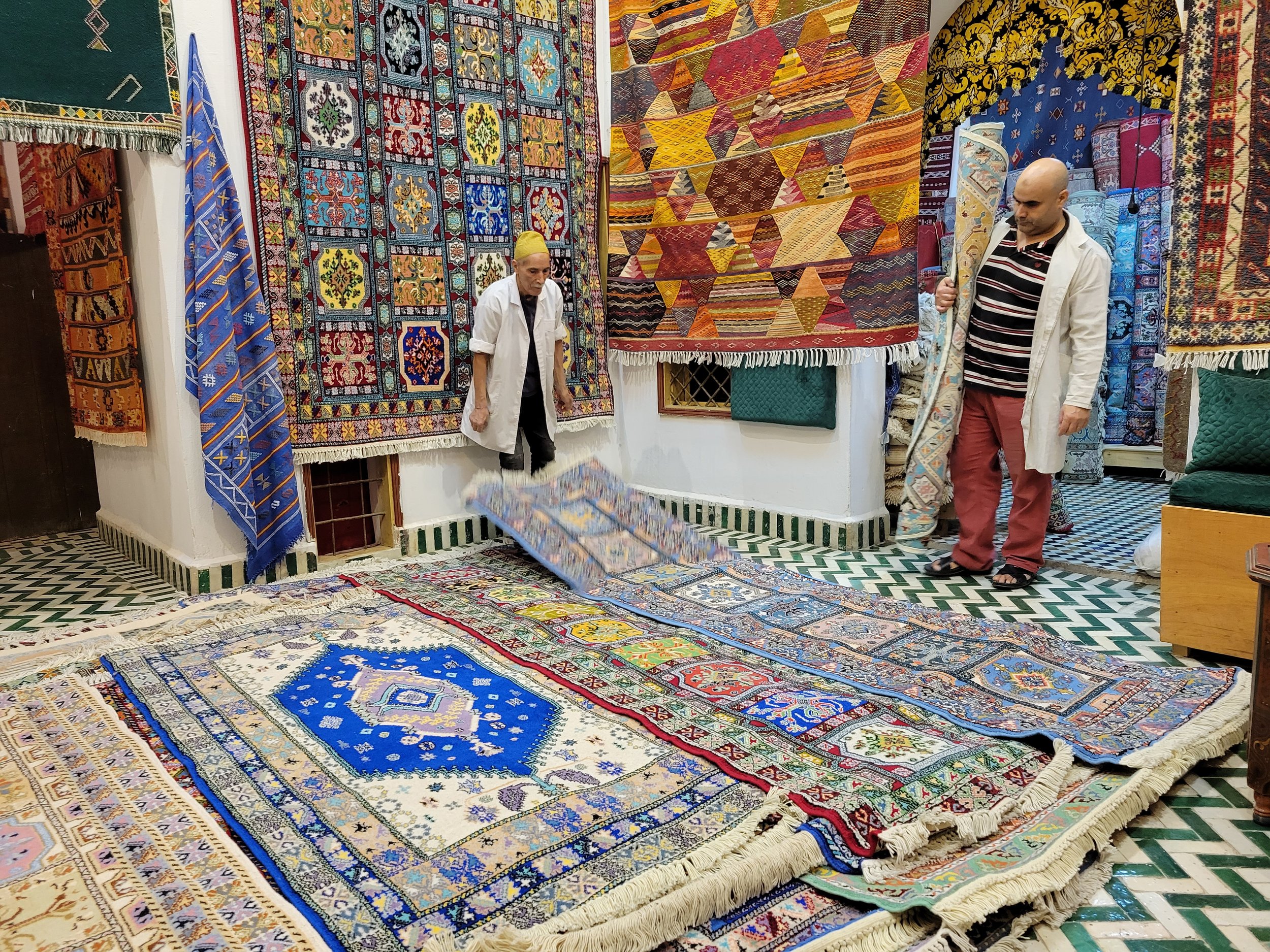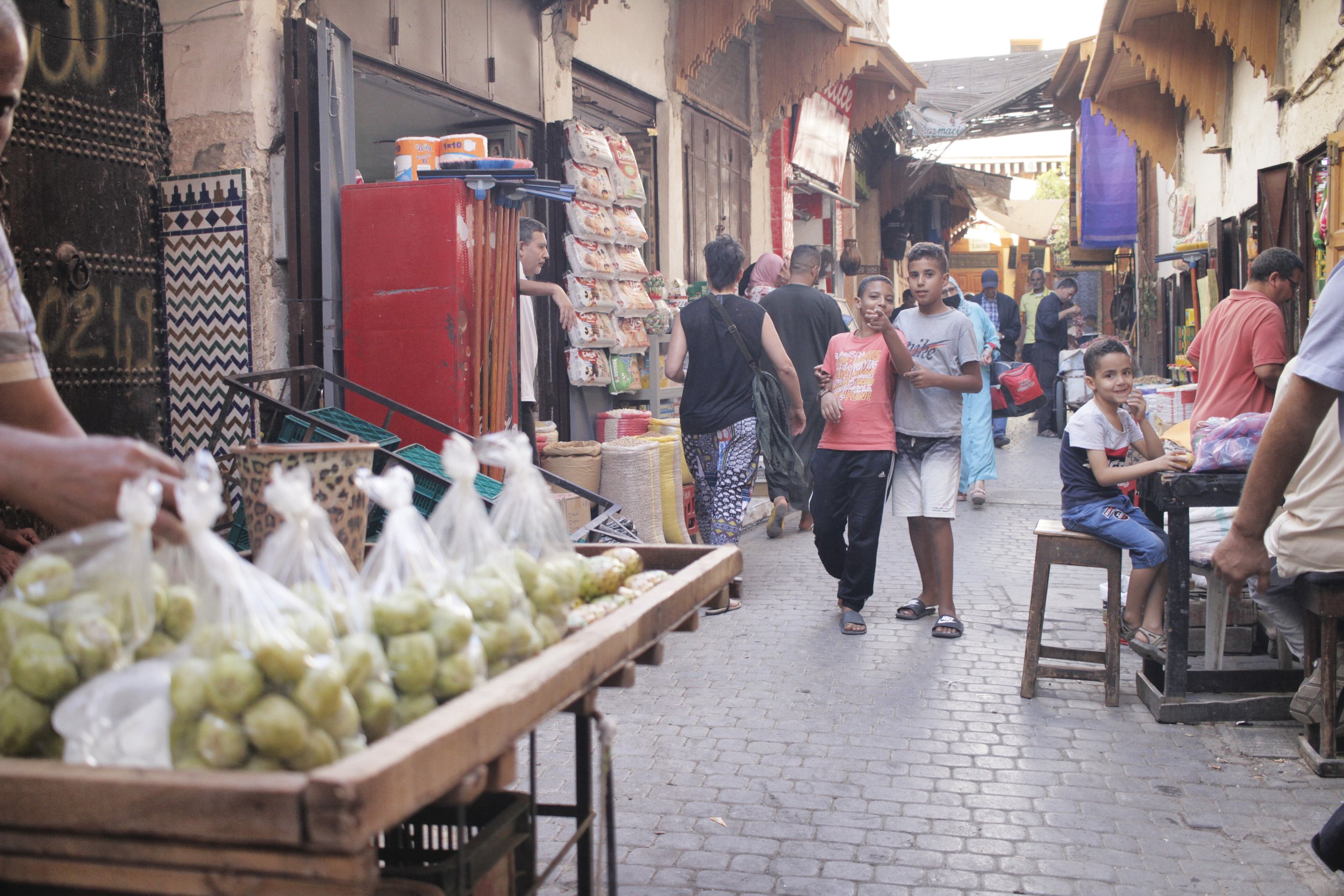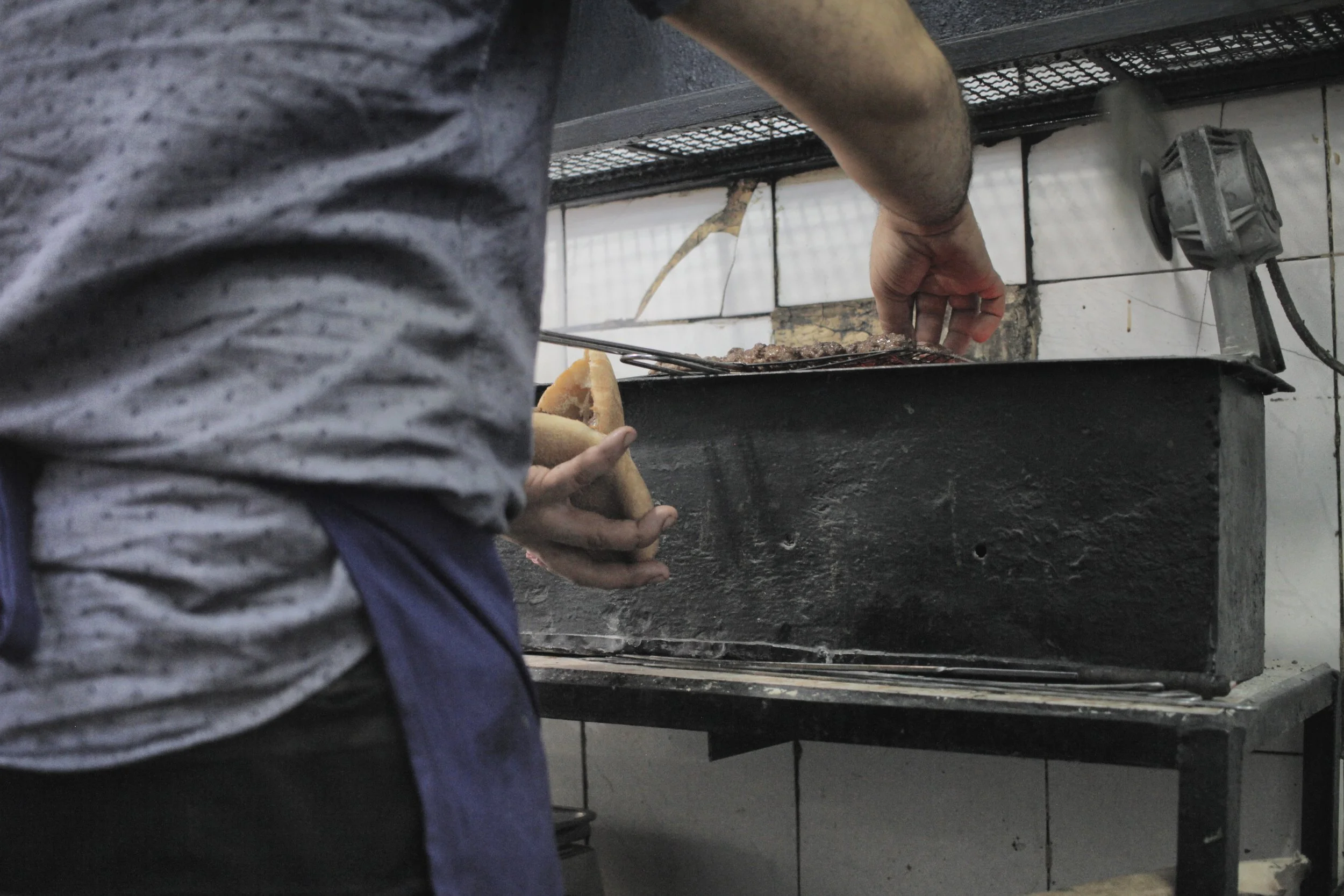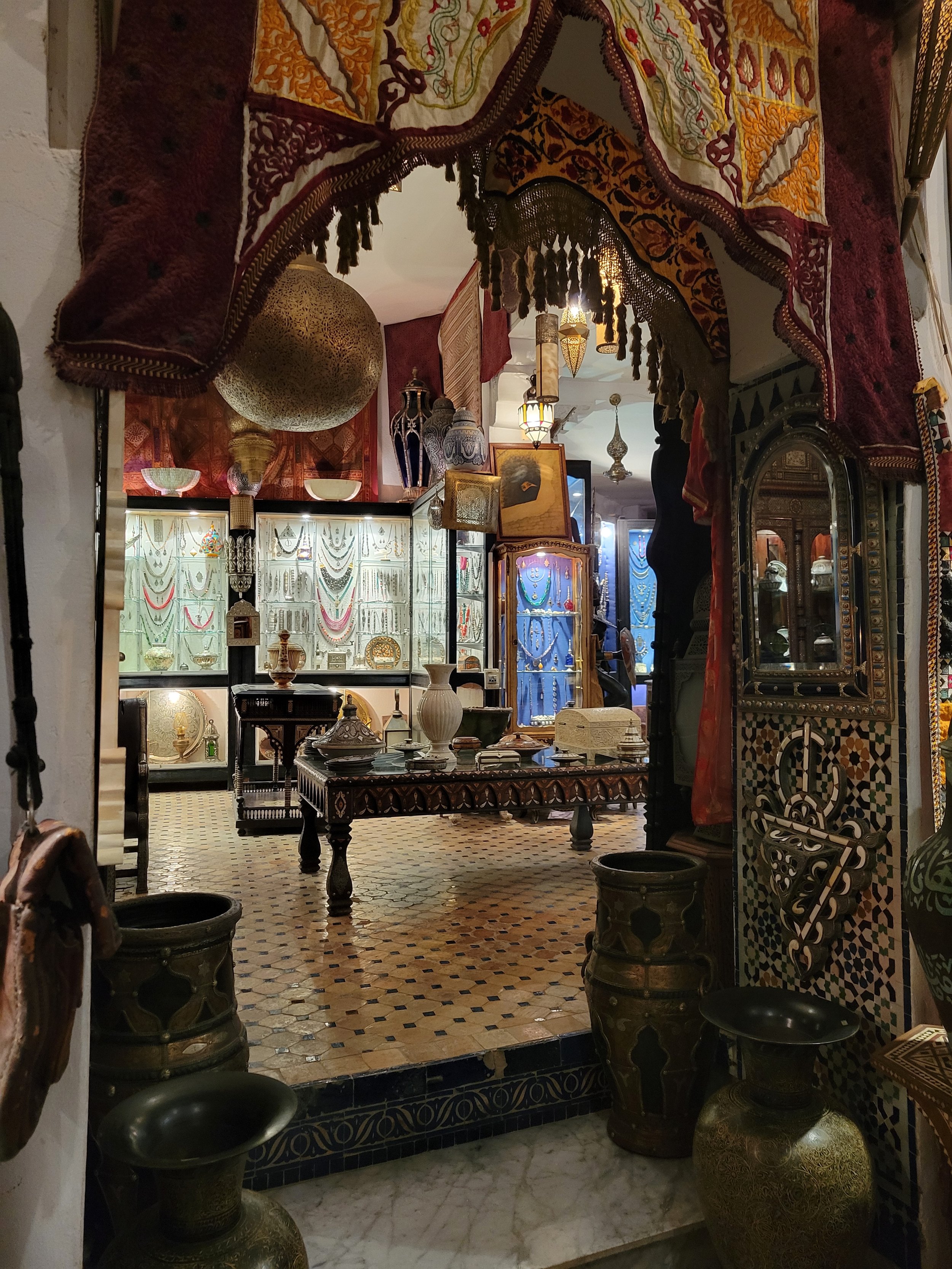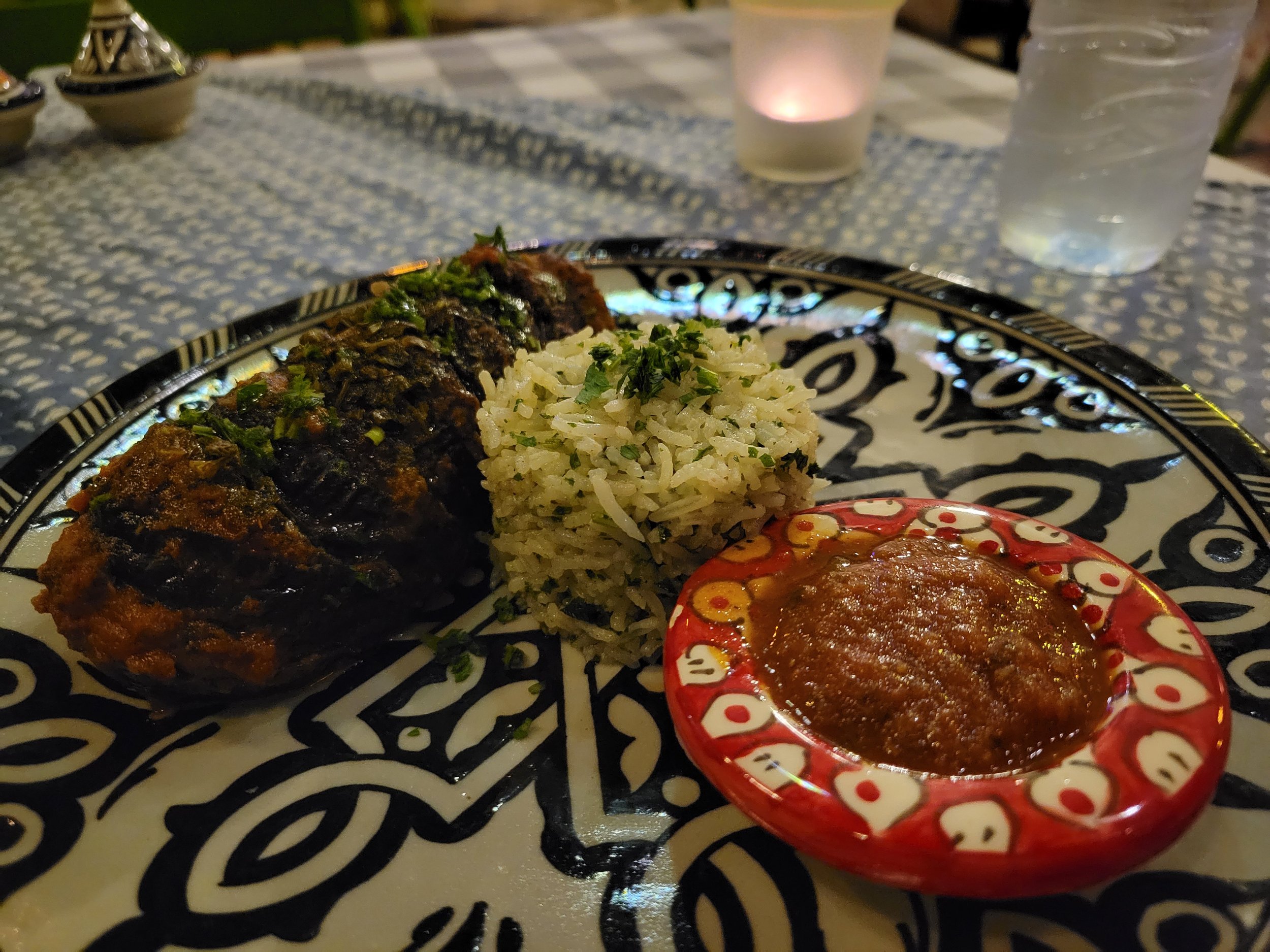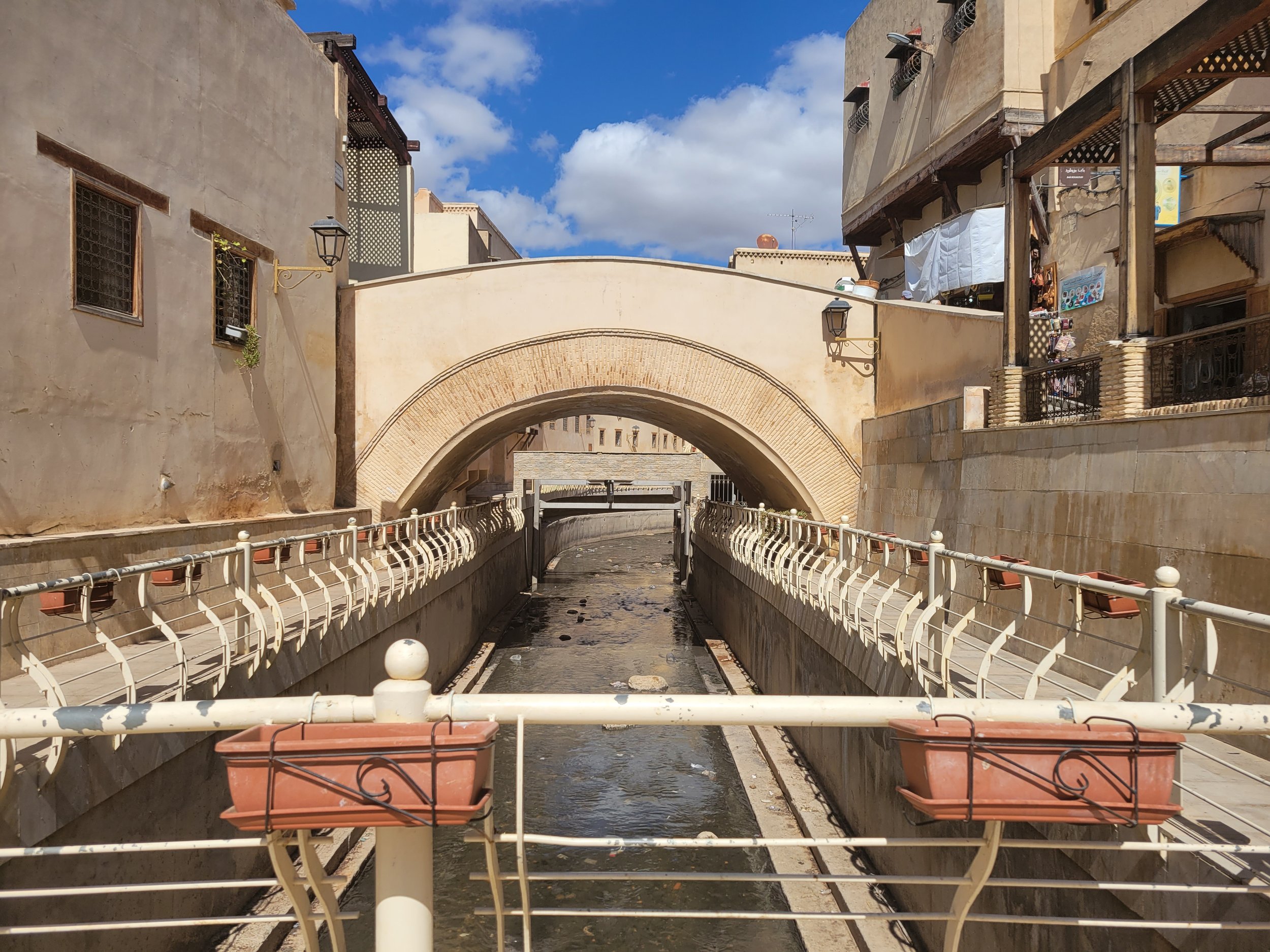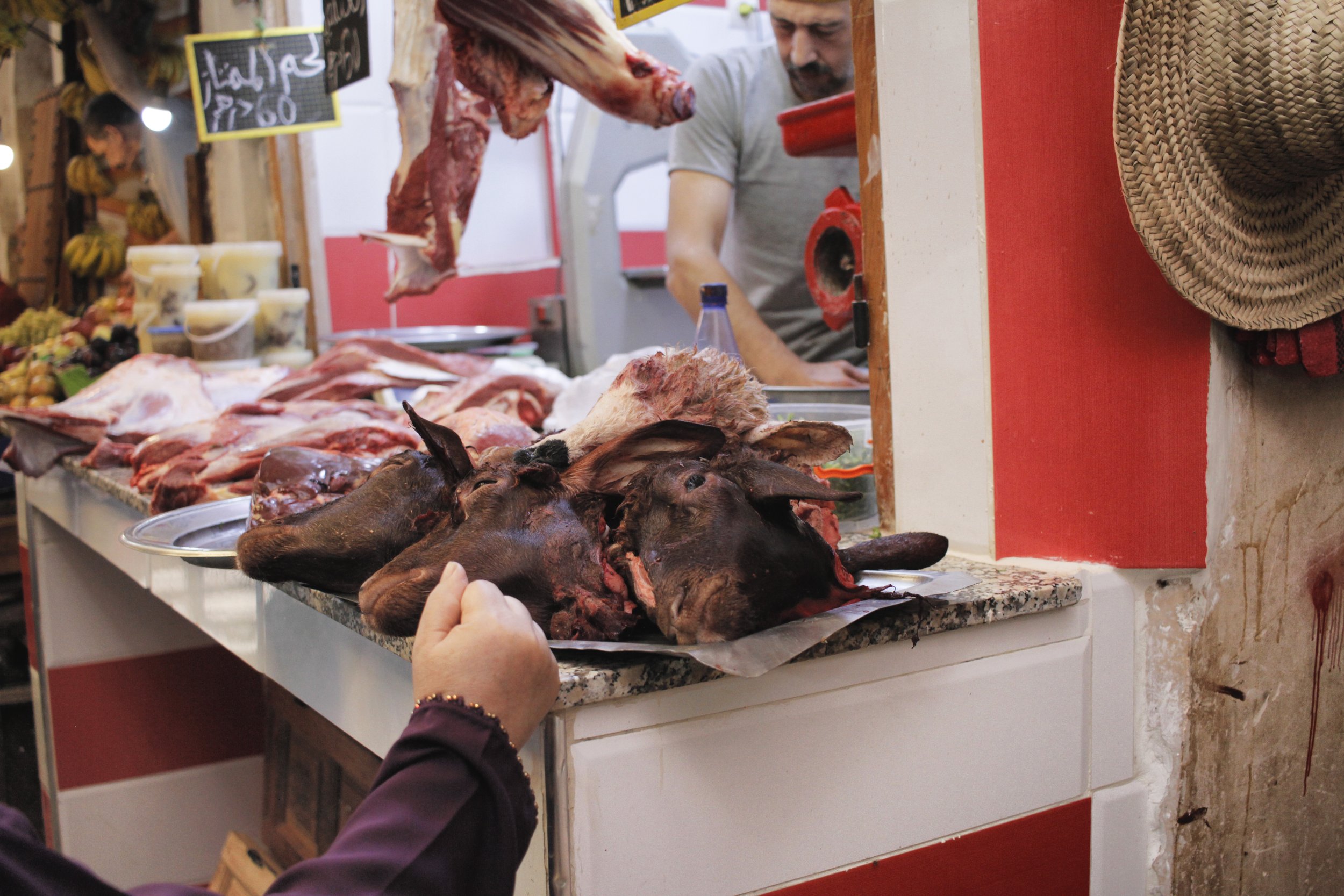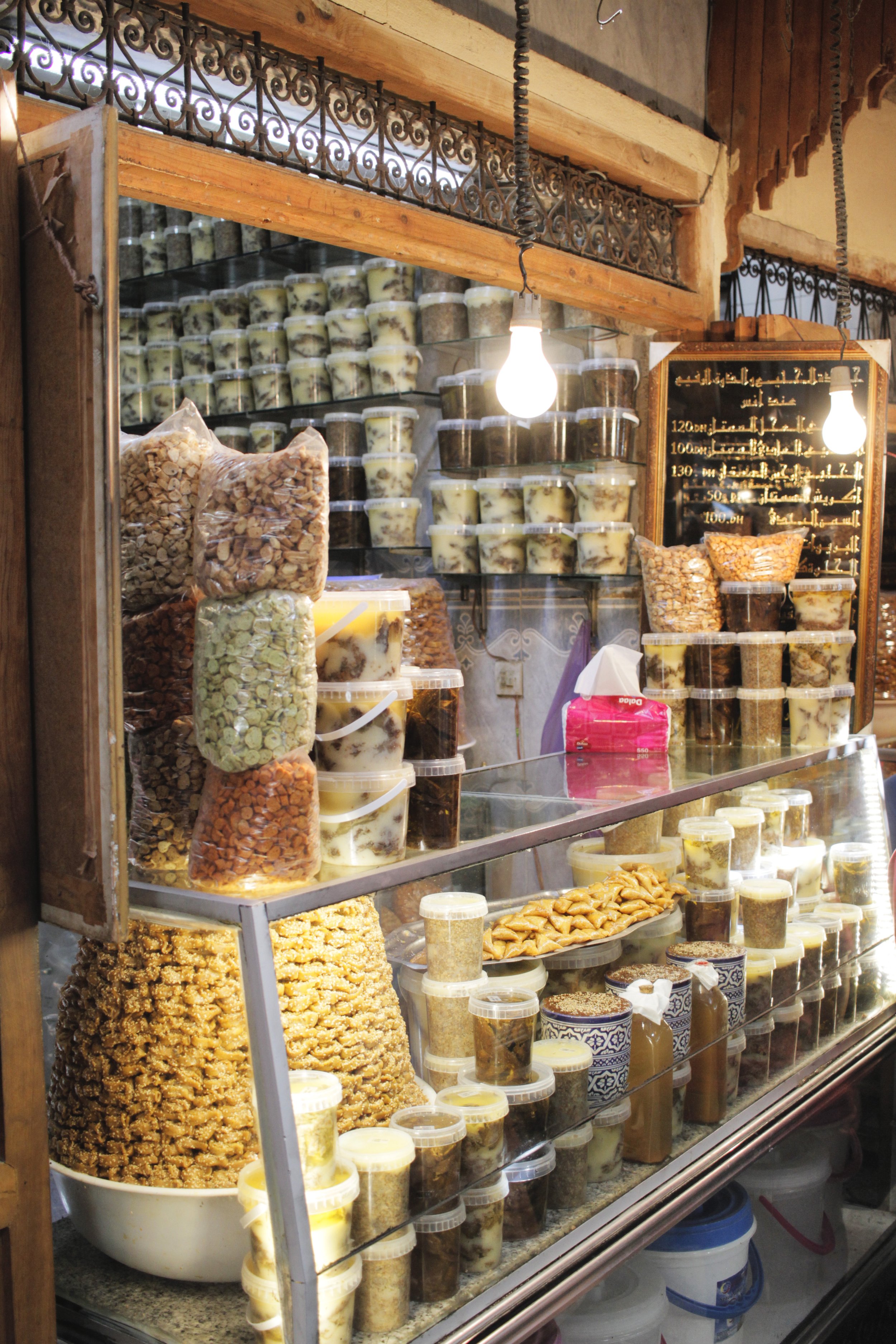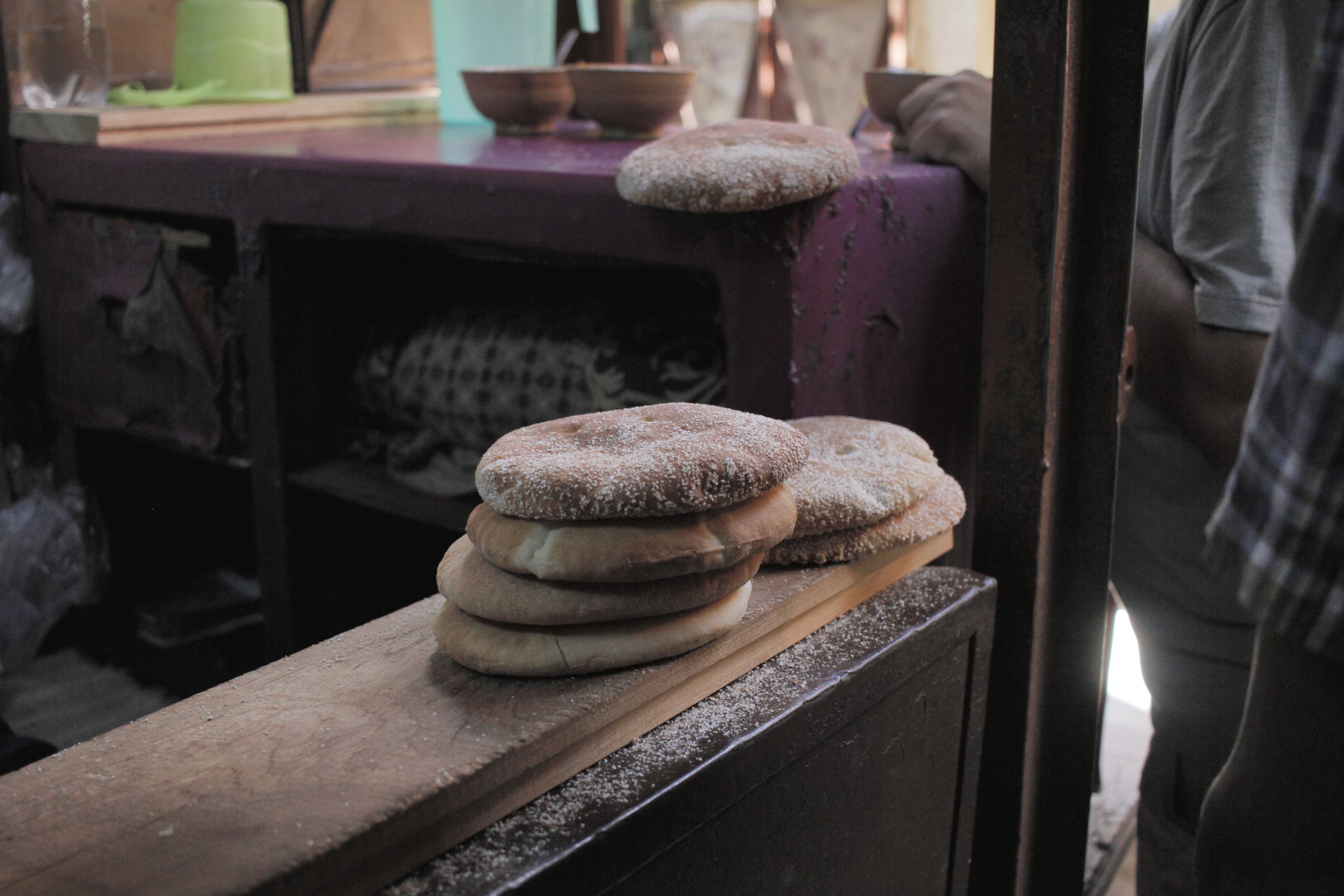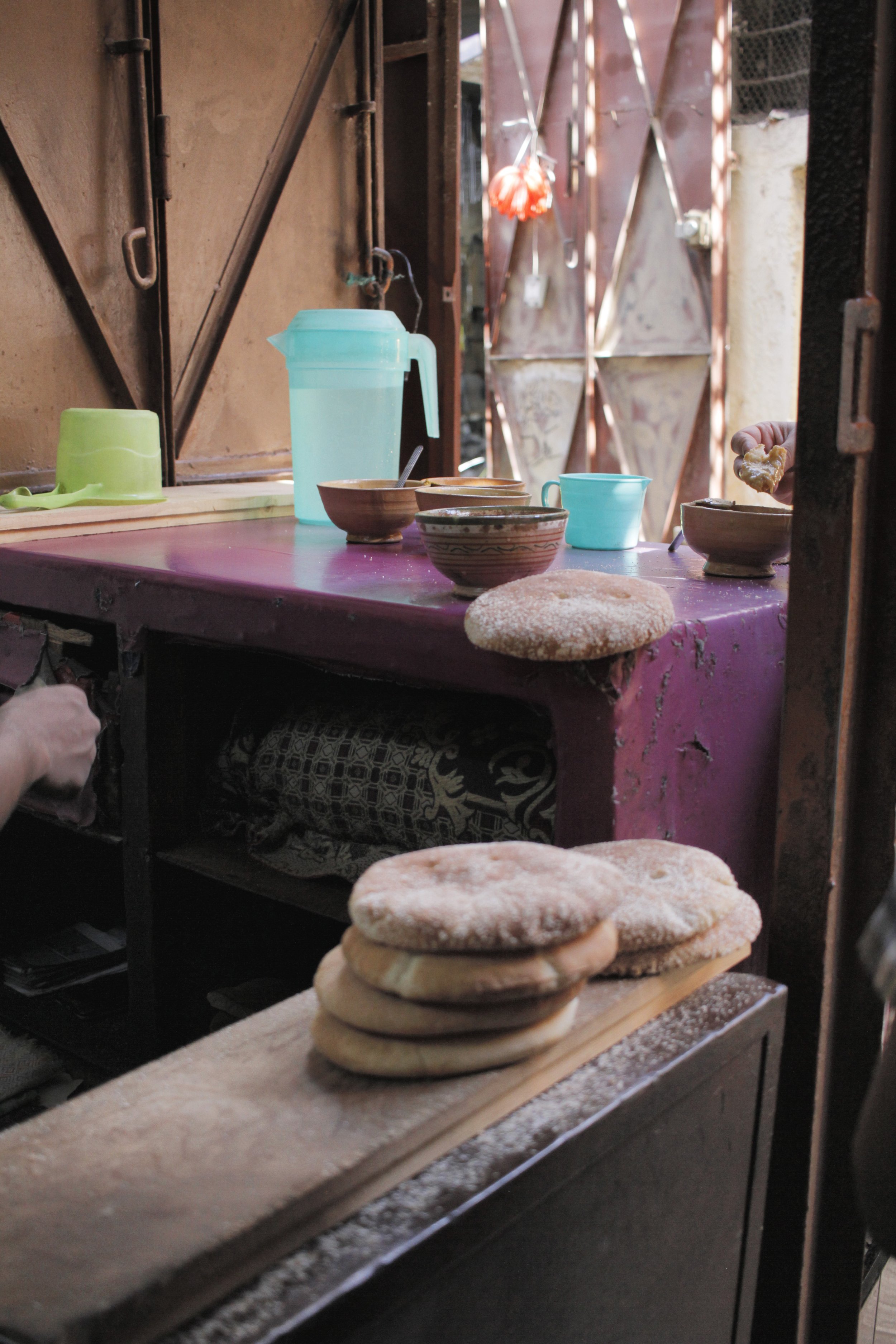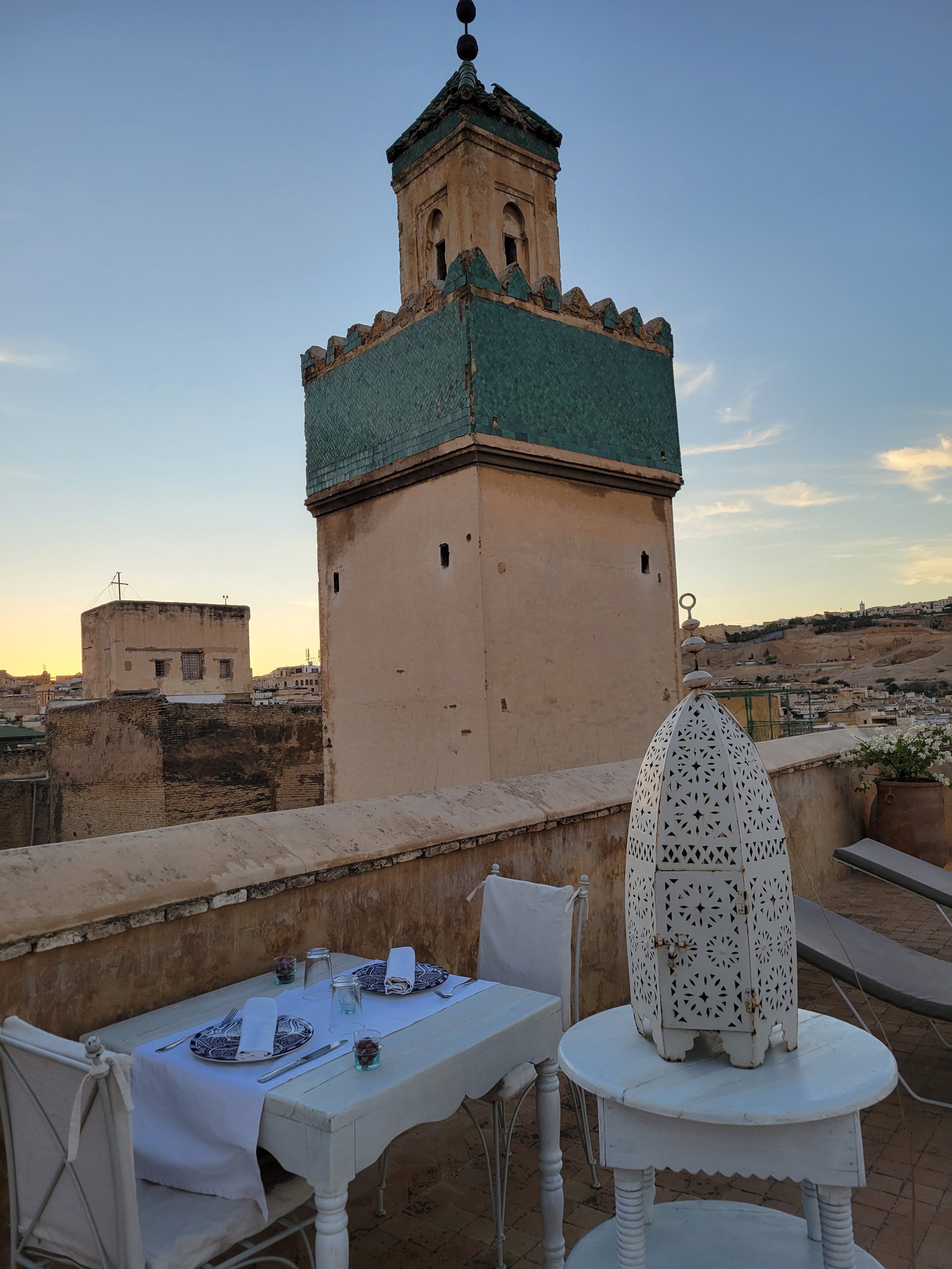Fes El Bali’s Walled Medina, Medieval Architecture & Old World Charm
Best things to do in Fes el Bali: discover all the magic of an ancient walled medina with this travel guide.
Arriving in Morocco was just as I had imagined, exactly like entering a scene from Aladdin. I’d hoped for a land filled with snake charmers, spitting camels and belly dancers thrusting their hips from side to side and I wasn’t far off.
Since its beginning in 788 AD by Idris I, Morocco has been under the rule of independent dynasties protecting its uniquely rich culture centered on religion and tradition. Often called “The Arab West,” Morocco is known for its Berber, Arabian and European cultural influences.
This North African country borders both the Atlantic Ocean and Mediterranean Sea and is home to the world's largest desert, the Sahara Desert. It’s also famous for diverse landscapes including beaches, mountains and ranges.
As for Fes or Fez, as it’s often spelled, this northeastern city is referred to as the country’s cultural capital, primarily known for its walled medina, Fes El Bali. The walled medina is packed full of historical museums, gardens, traditional hammams, leather tanneries and shops selling goods of all kinds including Moroccan rugs, antiques, textiles, jewelry, metalwork and pottery.
Fes is the second largest city in Morocco, previous capital and a favorite among tourists looking to experience the country’s distinctive architecture, culture and handicrafts.
All this to say, Fes is an enchanting destination not to be missed.
Our whirlwind adventure around Turkey and Morocco began in Istanbul, where East meets West: one city, two continents.
Then it was on to the hot air balloons and fairy chimneys in Cappadocia and its southwest region home to Pigeon Valley, Selime Monastery, Ihara Valley and Underground City.
From Cappadocia, we moved on to Morocco with flights into Casa Blanca and a train ride northeast into Fes. Once arriving, we discovered the walled medina of Fes El Bali, its medieval architecture, vibrant souks and old world charm.
Later, we ventured outside the walled city into the real “Athens of Africa.”
Our last stop led us to Morocco’s “Red City of Marrakesh,” with a day trip north to enjoy homemade butter, argan oil and camel rides in the Atlas Mountains.
Best Things to Do in Fes el Bali
Breakfast / In Casa Blanca & catch a train to Fes
Discover / What Riad life is all about
Explore / Fes el Bali's walled medina
Exhaust / Yourself shopping for Moroccan rugs
Hold / Your breath at Chouara Tannery
Scrub / Down & cleanse at a Moroccan spa
Sample / Moroccan street food in Fes medina
Relax / With a private massage & enjoy a rooftop dinner
Best Things to Do in Fes el Bali
Breakfast in Casa Blanca & Catch a Train to Fes
Using Casa Blanca as a transfer city only, it was time to move on to our destination, Fes. Before heading to the train station, we sat for breakfast at a cute spot near our stay. To our surprise, Casa Blanca was mostly a French speaking city but we were able to manage. La Loge, a little French café, served up a full breakfast. Included were omelets with prosciutto and cheese, salad, bread, yogurt and strawberry sauce, crepes with Nutella, juice and coffee or tea for less than $5 USD (38 MAD or Moroccan Dirham).
Fully satisfied, we hailed a taxi to Casa Voyageurs train station about ten minutes away. Although not the fastest way to travel, Morocco’s rail network has been around since the French colonized the country and still connects major cities, as well as smaller towns and villages. For an adventurous traveler trains are the way to go; they’re safe, comfortable, affordable, easy to hop on and off and full of great views.
Once at the station, we waited in line to purchase tickets at the counter but accidently selected second-class. After boarding second-class, we realized it was definitely worth a few extra bucks to upgrade to first-class, costing about $25 USD for two tickets. First-class also offered air conditioning and seats away from the toilets.
In all, the train ride took about four hours to travel nearly 200 miles, stopping a number of times along the way. We chose a quiet cart with six seats and piled up our luggage all around us. At first the train felt empty but as time went on it began to fill, bringing in some really friendly passengers to pass the time. Every so often a vendor would pass by with a cart selling water, coffee and snacks.
Arriving in Fes felt like entering another world, a picturesque city with palm tress, bright blue skies and white plaster buildings adorned with intricate patterns. Leaving the train station, we had no idea what was in store for us but dripping in sweat and intent on finding out, we jumped into a taxi toward our riad a few minutes away, costing 50 MAD ($5 USD).
Pretty quickly we realized something bizarre was going on. Our taxi driver had stopped in a roundabout and seemed confused, telling us it was time to get out. It wasn’t until we grabbed a boy from the street that we learned our riad was inside the walled medina. And because vehicles are not allowed inside and wouldn’t even fit down the narrow alleyways if they tried, our driver stopped once we got close to the entrance nearest our stay. Then he called our hotel to send a helper to lead us into the walled city. Soon, we’d learn there are thousands of streets, like more than 9,500, and even locals often find themselves lost without a guide. Not even Google maps can help a girl out.
Discover What Riad Life Is All About
Traveling through the maze-like streets of the walled medina was like stepping back in time. Laid out in the ninth century along the Fes River, Fes el Bali, has been an academic and commercial center of North African and Muslim life for centuries, claiming to be home of the oldest university in the world, University of Al-Karaouine, founded in 859. Socially and architecturally, Fes reached its peak in the 13th and 14th centuries but remains a cultural and religious center though no longer the capital city. The medina itself was named a UNESCO World Heritage site in 1981 and is one of the largest car-free urban zones in the world. Talk about impressive but also be cautious if you’re at all claustrophobic as the tiny streets can sometimes feel like they are caving in on you.
Aziz, a large Moroccan man with kind eyes, met us outside the walled city, collecting our luggage and requesting we follow him back into the medina from which he emerged. He guided us in and out of the windy narrow streets while I tried to keep track of our route. In my mind I repeated, left, left, right, left, right, right, right, left but eventually I lost track. We were officially at his mercy. After about ten minutes we reached our riad, the gorgeous رياض دار Riad Dar Bensouda.
From the moment we entered, we were in awe. The smooth stone of the worn dusty streets had turned into intricate tile patterns in geometric motifs, ornately carved wooden doors standing over 20 feet tall and fountains shaped like stars. An open air courtyard lead our eyes upward three levels to an opening framing the clear blue sky. Yassine, our host, greeted us with tea and cookies, followed by a tour of the stunning palace turned guesthouse.
Until now, I’d never even heard of a riad so, what exactly is it? A riad is a type of traditional Moroccan home designed with two or more stories surrounding a symmetrical interior garden and fountain with its origins attributed to Persian gardens spread during the Islamic period. In the past, riads were city homes of the wealthiest residents but today it’s foreign interest that’s helping turn many of the decaying structures around. These guesthouses and hotels providing shared common areas and private rooms are so popular that they are being restored at record number, reviving many of the handcrafts and artisan trades that have been slowly vanishing over time.
As history goes, Riad Dar Bensouda was built in the 17th century by a holy man in Islam named Tawdi Bensouda. Not only was he a writer, scholar and imam but he was also an advisor to the sultan, Moulay Slimane. Bensouda built this house for his family where it remained for several generations until it was purchased by another family in the 19th century. The Skalli family, famed musicians of Andalusian Moroccan music, played music regularly in the courtyard and became known for hosting famous guests from the Arab world.
On walking through the front door you’ll find yourself standing in the midst of an architectural masterpiece, the huge courtyard of Dar Bensouda. As a student of design, the scale, detail and symmetry were what really caught my eye, not to mention the play of light and shadow as the sun moved across the sky. No matter which vantage point you found yourself, it was simply breathtaking. Our tour began there in the courtyard and weaved up and down the hidden staircases, reaching new vantage points and secret salons. With the maze-like design, I was nearly lost at every turn.
After exploring the interior of the riad, we found ourselves outside on the rooftop. The view of Fes el Bali from above was staggering, countless buildings woven tightly together in the walled city like a jigsaw puzzle. There was something so overwhelming, yet satisfying about it.
There were a number of lounge areas, some more casual than others, as well as views back down the central courtyard into the riad. Truly, I can understand why rooftops are so important to riad life. They offer another sanctuary away from the crowded streets of the walled medina and nearly the only place where you can see the open sky.
It was also up on the rooftop where we learned that the riad was built next to a mausoleum for the Bensouda family. Here, they buried their most important and educated family members, both male and female.
Out of curiosity, I wondered if it was possible to enter the mausoleum but it looked so overgrown I didn’t have the heart to ask. It was also very interesting that the Bensouda family buried their loved ones so close to home.
All in all, I couldn’t wait to get back onto the rooftop to enjoy some sun and cocktails. It was definitely one of the highlights during our tour.
Yassine was kind enough to show us a few of the rooms and let us select our favorite. At last, it was time to settle in; we chose one off the main level with a door so tall there was another smaller door within. Although the space was massive, huge swaths of fabric stretching across the entryway, Moroccan rugs and delicate lanterns helped make the room feel nothing less than cozy. A small staircase lead up to a dimly lit bathroom and jacuzzi tub.
All our exploring had worked up an appetite so we ventured down to the main lounge, where the riad served bites to eat poolside.
The tropical feel and plush seats covered in red velvet were so inviting but the pool was a bit too chilly for a swim.
We took refuge in the plush lounge seats next to the pool and picked an assortment of dishes from the menu. This would be our first real meal in Morocco and it was well deserved.
One by one, the dishes began to arrive: stone fruit, cauliflower, olives, eggplant, zucchini, hummus, kebab, meze and bread with a mixed avocado and milk drink. Many of the dishes were strong in vinegar but tasty nonetheless.
After eating, we returned to the rooftop to enjoy the sunset over Fes.
The colors of the sky changed slowly and without warning. We found the mountains and cityscape mesmerizing.
Round and round the rooftop we went, discovering the medina from every viewpoint, taking note of where the walled city began and ended.
There were also a number of minarets surrounding us, jutting up into the sky. A minaret is a tower typically built into or next to a mosque. They’re generally used to project the Muslim call to prayer, which we did hear during our stay, but they also serve as landmarks and symbols of Islam’s presence. Though a Muslim country, Islam is the largest religion in Morocco with more than 99% of the population adhering to its teachings.
In addition, after Egypt, Sudan and Algeria, Morocco is the fourth most populous Arab country. Most Moroccans are Sunni Muslims of Arab, Berber or mixed Arab-Berber decent.
In the coming days, we’d venture out into the medina and even outside the city walls to experience the true character of Fes but we were so excited to reach this shiny pearl, Dar Bensouda, in the heart of the labyrinth medina of Fes.
It was a true oasis, a sanctuary from the busy life moving about in the medina.
Credit goes to the patience of Abdellatif Aït Ben Abdallah, a man well-known for his work protecting the heritage of the Marrakesh medina and researcher of Moroccan architecture and tradition.
In 2005, he purchased the riad and fully renovated the space without changing any of the design elements, taking care to preserve all the special details. With the same lime plaster, massive wooden doors, traditional zellij tiles and moucharabia (balcony), Dar Bensouda was restored to its original condition.
After breathing life back into the riad, Abdellatif Aït Ben Abdallah decided to open its doors as a guesthouse showcasing its incredible beauty and architectural wonder. This Fes guesthouse had finally regained its original soul and we were happy to take advantage of it.
That evening, our riad recommended dinner at nearby restaurant called Fondouk Bazaar. Even as we entered, we knew we were in the right spot. On the first level, the restaurant was thoughtfully designed with oversized planters and beautiful colored lanterns hanging from the ceiling. To enjoy the warm weather, we opted for a table on the rooftop. Just as we sat down, the call to prayer began and went on for some time. It was quite lovely to hear the voice chanting through the darkness and there was something so comforting about it.
Excited to try more Moroccan specialties, we ordered a bunch of delicious dishes. We chose a mixed juice of bissap or roselle juice, made with flowers of the roselle plant, a variety of hibiscus, strawberries and mint lemonade, along with a ginger lemonade. For starters, we selected hummus, taktouka, a savory traditional Moroccan spread made from tomatoes, bell peppers, garlic, toasted paprika and olive oil, feta cheese cigars and a salad of watermelon, beets, feta, peaches, cucumber and mint, drizzled with balsamic vinegar.
The fruit salad won me over at the first bite. It was so unexpected; sweet and savory with nothing but the freshest ingredients and fragrant herbs.
As a main course, we went for the homemade tagliatelle with veggies, parmesan and an herb sauce. It was absolutely delicious and if this meal was any indication of what was to come, we were in luck.
Explore Fes el Bali's Walled Medina
On our first full day in Fes el Bali, we had to hit the streets for a walking tour. Early in the morning, we joined our riad for breakfast near the pool. A long table was spread with what we could only assume was a traditional Moroccan breakfast, buffet style. There were crepes, various types of breads, jams, butter, honey, melon, orange slices sprinkled with cinnamon, olives, cheese, coffee and tea. And if that wasn’t enough, you could also add an omelette or fried eggs.
Yassine, our host and newfound friend, took us out for the day on a tour of the medina which would include visiting some of the main sites and handicraft locations inside the walled city.
We stepped out into the dusty alleyways to discover and learn all we could about Fes. Right away, we noticed vendors selling embroidered decorations which Yassine explained were used in marriage ceremonies. In Morocco, it’s tradition to go all out for weddings and parade through the streets in celebrations that can last for days.
Funduq al-Najjarin or ‘Inn of the Carpenters’ is a historic funduq or traditional inn located in the old medina quarter. The building was designed to be used by merchants, traders and visitors, providing a storage place and market for carpenters.
Today, it houses a private museum, Le Musée Nejjarine des Arts et Métiers du Bois (Nejjarine Museum of Wooden Arts & Crafts) and is an important example of Moroccan riad architecture.
Zawiya of Moulay Idris II is a building and institution associated with Sufis in the Islamic world used as a place of worship, school, monastery and mausoleum. It contains the tomb of Idris II, founder of the city of Fes and ruler of Morocco from 807 to 828. Located in the heart of the medina, it’s considered one of the holiest shrines in Morocco.
I thought it strange the entrance seemed to be blocked by a gentleman selling goods but regardless, it was impressive, even from the exterior.
Many of the streets leading toward the zawiya are marked with horizontal wooden beams under which pedestrians must duck in order to pass. Historically, these signify the extent of the zawiya’s sanctuary or haram, a protected area.
Up until the beginning of the French colonial occupation in 1912, non-Muslims and pack animals such as dogs and mules were prohibited from passing beyond this point, and any Muslim within this space was granted asylum from arrest. These days, non-Muslims are not allowed to enter the building but can walk up to its doors and admire the exterior, which is exactly what we did.
Yassine then took us through some of the original markets, or souks, with stalls made of wood. At some point there was a fire causing damage but as part of UNESCO, they are working on rebuilding the market back to its original state.
Another stop along the way was University of al-Qarawiyyin, where we only peaked our noses inside as students disappeared through the massive wooden door. al-Qarawiyyin claims to be the oldest university in the world, founded as a mosque by Fatima al-Fihri in 857-859. From then on it became one of the leading spiritual and educational centers of the Islamic Golden Age, a destination for students and scholars alike. Then, it officially became a state university in 1963 and was renamed "University of al-Qarawiyyin" two years later. The mosque itself is also noteworthy, a complex of historical Moroccan and Islamic architecture with characteristics from many different periods of Moroccan history.
Exhaust Yourself Shopping for Moroccan Rugs
Straightaway, after entering Art Gallery Attarine, we were whisked upstairs for a view of the city and brief history lesson of the area.
The gallery claims to house a selected collection of antiques and works of art including carpets, kilims (pileless textiles), bronze, silver, wood, plaster, Berber jewelry, pottery, paintings, weapons and many other authentic items.
After moving back downstairs, what came next was equal parts terrifying and intoxicating. It began with a brief introduction of seven or eight different types of carpets, paired tiny cups of mint tea and honey cookies shaped like little moons, called kaab el ghazal or gazelle horns.
Frequently served at special occasions, these little treats were meant as a distraction.
Tip / Only proceed if you’re either good at saying no or willing to spend a good chunk of money. Vendors are very persistent and of course, everything is gorgeous, so it’s tough to pass up, “This is my only chance” mentality. Most importantly, haggle and assume you can get prices down at least 50% from the original but this might take some time and finesse. Also, consider walking away and coming back when emotions aren’t running as high.
The gentleman in charge began; every carpet has been traditionally woven in Morocco by women of various tribes. Morocco Berber carpets, specifically, are handmade by the Berber people in North Africa and the Sahara by weavers who have not been formally trained. Because nomadic people often carried their looms from one place to another, many rugs are not wider than seven feet.
Berber carpets are woven from pure sheep wool in different piles and thicknesses according to each region. In the Atlas Mountains, Moroccan throw rugs are made with a thicker pile to ward off the cold and snowy weather, while lighter flat weave rugs are made for the hot climate of the Sahara Desert.
Each tribe has a distinctive style based on local access to natural plants and minerals, as well as knotting patterns and technique. The designs have been passed down through generations of weavers and are woven from memory rather than using formal patterns.
Each floor covering is considered unique and one-of-a-kind, taking anywhere from two weeks to six months to create depending on the size and complexity of weaving by hand on a loom. These tapestries, often used as floor mats, blankets, bed coverings or even burial shrouds, typically depict a weaver’s life story, including symbolism that represents birth or fertility along with motifs that illustrate phases of a woman’s life such as childhood, virginity, courting, creating a union, pregnancy, birth and a newborn child.
The colors used in each textile also have meaning; red symbolizes strength and protection, blue means wisdom, yellow for eternity and green for peace. We also learned interestingly, that the older the carpet the more valuable and sometimes they even run over the rugs with a vehicle to give an older look and feel.
Some of the most popular styles of Moroccan rugs are Beni Ourain, Azilal, Boujad, Boucherouite, Moroccan Kilim, Taznakht, Beni Mguild and Mrirt rugs. Our guy explained each one, offering their distinctive characteristics and background.
Beni Ourain rugs are made by the Beni Ourain tribes in the lower Middle Atlas Mountains. These soft and warm rugs are used to insulate the floors from the glacial winters of the Atlas mountains. Popular for their minimalistic look, this style is typically known for black or brown geometric diamond motifs paired with a natural cream or ivory wool background. Designs are often mismatched or asymmetrical giving it a more personal touch and added charm. This style has historically been favored by designers such as Le Corbusier, as in Villa La Roche in Paris during 1923–1925.
Azilal rugs, made by the Azilali Berber tribes in the High Atlas Mountains, are traditionally woven by the matriarch of the family, sticking to an ancestral process passed down from mother to daughter for millennia. Each piece takes weeks or even months to complete depending upon its size and complexity. This hand knotted rug usually has a base of cream, ivory or white natural wool, paired with brightly colored wool dyed from regional flowers and vegetation. It’s also known for more geometric shapes with a plush and heavy pile making it perfect for personal use.
Boujad rugs can be found in soft, high quality wool with shades of deep red, pink, purple and orange and are handcrafted by Moroccan women from the central plains region of Haouz. This style has a typical knotting method practiced by Berber tribes using a tighter knot and less wool. Distinguished by their Moroccan motifs and geometric patterns, namely diamonds with a mix of lines and other shapes, boujad rugs are also colored from natural dyes of flowers, henna, berries and leaves.
Boucherouite is a term that means, the one with used fabrics. When wool is not accessible due to the transition from nomadic herding to more modern forms of employment, these rugs are made from used old fabric knotted together to create a beautiful and playful piece. These warm and durable rugs are visually captivating and full of color. They are also eco-friendly, heavy and easier to care for than standard woolen Moroccan rugs.
Kilim rugs come from women of the Atlas Mountains and are not as soft and thick as other wool rugs due to the nomadic tribes need for ease in packing and carrying them. They are flat woven rugs using beautiful colors and designs, and are incredibly durable and resistant to high sun exposure.
Taznakht rugs come in a wide range of designs, both simple and complex, and can be found in either neutral or bold colors. They’re most known for combining three different weaving styles, embroidery, knotting and flat weaving, to create a three dimensional design. The most common designs include shapes such as triangles and diamonds. This rug is also one of the most expensive due to its complex weaving techniques.
Beni Mguild rugs use a plush, thicker weave for the colder climates in the western Middle Atlas region. During warmer months, they can be flipped over, plush side down, to use the flatter surface. They are woven on a vertical loom using deep shades of purple, blue, red and brown.
Beni Mrirt rugs are the most intricate and often most valuable of all Moroccan rugs. They are distinctly dense, knotted with double knots and designed to give a rich silky texture underfoot. These exquisite rugs are woven with the highest quality of pure New Zealand wool, naturally stain resistant and even capable of withstanding a fire. The Beni M'rirt tribe of the Middle Atlas call their pieces "shadow carpets" by focusing on rich colors from vegetables instead of design patterns.
All this to say, just how intense the carpet buying experience actually was. Around this time, I started thinking, these snacks are nice and all but not that good. “How the hell do we get out of here?” And, wait. “Do I even need a rug?”
From then on the mood got a bit more desperate. After the rugs hanging on the surrounding walls were described, a few men began heaving rolls of carpet about. One by one, they were unveiled them in a grand manor, flung out with a strong wave-like motion. It was our job to respond either “haali” (keep it) or “ishmaa” (take it away) which only slightly lightened the mood. It had turned into an intense game of speed dating and they were watching our every move.
Before us were all kinds of rugs: big ones, small ones, skinny ones, long ones, round ones, rugs with deep saturated colors and others with neutral tones, some with intricate patterns and others with simple geometric shapes. It was an endless game and at first, we didn’t see anything that interested us so it was quite easy to pass. Ishmaa. Ishmaa. Ishmaa. But eventually the mood began to change, things started to feel lively, exciting even. This was a game so maybe we should enjoy yourselves.
It must have been 100 rugs that were brought out and rolled open before our eyes. We were asked to indulge ourselves and set aside anything we might be interested in even if we weren’t planning on making a purchase. This seemed fair until we started to get, dare I say, guilted into considering a purchase.
The gentleman described how women in small villages weave these rugs for months on end, that they need the money to feed their families and this guy was generous enough to give them nearly all the purchase price. There’s no middle man here.
Again and again, the rugs were rolled out, overlapping each other to the extent that I couldn’t tell where one stopped and the next began. Any time we whispered “haali” (keep it), we were commended for our choice. “That is one of our nicest rugs, so and so made that from this village and worked 1,000 hours on this piece. It would mean so much to her to sell this. You will enjoy this rug for years to come. Everyone who comes over to your home will ask you where you got this beautiful piece.” I mean, they were relentless. And once they learned I was an Interior Designer, it was suggested that we buy multiple rugs to take back home and resell, as if we didn’t already have full time jobs.
After about 45 minutes of this display we were left with five carpets that had peaked our interest. And just for fun, we entertained the idea of hearing the price. The man pulled out a wrinkled piece of paper and began scribbling down numbers. When he was done he handed it over to me and I just about fell off my seat. I thought I had misunderstood the currency. It was over $10,000 USD. I couldn’t help myself but laugh out loud. This had officially entered fantasyland. The man was not phased. “How much can you spend?”
From there, things got a little blurry. Somehow I thought my partner was dying to have one of the rugs and she thought the same of me (really neither of us were dying for one). But this guy had created enough of a story that there was no turning back now. Immediately, we narrowed down the rugs to an intricately woven runner and more of a blanket style bed throw made with agave silk. With two rugs, we were able to get the price down tremendously but still ended up spending nearly $1,000 USD more than we felt comfortable. Our total cost was $1,000 USD for the runner and $500 USD for the bed spread.
With a handshake, a few of the sweaty men wrapped up our two rugs, tightly and neatly sewn into a thick plastic tarp (I almost just wanted to buy a rug purely because of all the manual labor they endured). Credit cards were swiped and the carpets would be delivered to our hotel in a few hours. Voila!
All in all, we really love our rugs but regret not being fully prepared for what we were pulled into. I’ve also learned since then that if you go into these shops with a guide they automatically get 10% or more of the sale so better to go on your own and shop around until you feel comfortable.
Hold Your Breath at Chouara Tannery
From that emotionally and mentally exhausting experience we were happy to move on to something a bit lighter. And on our way to the tannery we found the tiniest “street” in Fes.
We also passed a number of vendors selling leather products street side and learned they mostly make goods out of scraps from the larger tanneries.
Chouara Tannery is the largest and one of the oldest tanneries inside the walled city. It’s located in the oldest medina quarter of the city, near Saffarin Madrasa along the Oued Fes, the river and main source of water for the city flowing right through its center. Since the birth of Fes, the tanning industry has been operating as it did centuries ago. This location is one of the most popular tourist attractions, as they have some incredible goods which are sold onsite and also exported around the world.
Tip / Grab some mint on your way in to offset the rough smell.
First things first, as we entered it was recommended to grab a few sprigs of mint and rub it below your nose to offset the overwhelming smell. Once that was taken care of, we climbed a number of steps leading into an upstairs area that ultimately opened up into blue skies and dozens of vats filled with various shades of liquid.
To produce leather, the first and most important step after washing the hides with water is to soak them in stone vats of white liquid made from a mix of cow urine, pigeon feces, quicklime (calcium oxide), salt and water. This white liquid cleans and softens the tough skins, killing bacteria, removing hair and preparing them to absorb the dyes. Hides of cows, sheep, goats and camels stay in the white liquid for two to three days until they are removed and placed into vats containing colored dyes. These natural dyes come from local plant life; red from poppies, blue from indigo and orange from henna, among others. The hides are soaked for three months, finally being removed and dried in the sun before turning into a jacket or handbag.
Most remarkable was the scale of the site itself, as well as the grueling work going on down below. The men had to be boiling in the heat, not to mention the intense smell. They were in charge of stirring the liquids with huge wooden rods, moving hides from one vat to another and cleaning out the containers as needed.
Plus, if someone so much as misstepped, they’d fall right in to the stinky liquid. All things considered, it was really cool to see such an interesting place right in the middle of a busy city.
It was finally time to see what the tannery had to offer by way of leather goods. With multiple levels to explore, we thoughtfully moved through each area. There were stacks and stacks of handbags, poufs and slippers, along with entire rooms filled with leather jackets and pants of all kinds. It was overwhelming to have so many options but helpful that our guide inside the tannery wasn’t pushy. He was kind and quiet but eager to assist when needed.
In the end, we picked up a leather jacket, which by the way, they tailored on the spot, completing alternations within a few hours and dropping it off at our hotel, a pouf and slippers, all for reasonable prices. Now, when I say reasonable, Morocco knows its value. Everything I loved from brass lamps to leather poufs to jewelry to rugs and throws and cashmere scarves, was priced fairly but not cheaply. The craftsmanship and pride for each product was something else.
Another special stop along the way was a small jewelry store where I purchased an antique silver cuff with incredible detail. Of course, it was more than I expected to pay but worth it.
Then our guide took us for some street food at a popular BBQ spot where we ordered a few chicken and ground beef skewers. We squeezed into the tiny dining area behind the grill and sat down to wait on a wooden bench.
Covered in smoke and sitting next to a handful of Moroccan women, we all watched as the vendor prepared each order until it was our turn. He placed our skewers into some chewy bread and handed them over, recommending we top it with salt, cumin and tomato sauce. What a fun authentic experience and delicious, too.
As a teaser, our guide suggested we browse a super fancy bazaar filled with antiques of all kinds. Curiously, we entered the shop; it was truly like nothing I’d seen before.
The antique shop was absolutely stunning, every piece was museum quality, ornate and full of detail; so much to look at, it was hard to focus on one thing. Inside, there were rugs, sculptures, lanterns, paintings, chests and armoires, dishes, jewelry, vases, tapestries, tables and chairs, it was endless.
Every surface was covered in glistening metal, stone or jewels and the only thing more astonishing than all the gorgeous antiques were the price tags with most pieces ranging in the hundreds and thousands.
Scrub Down & Cleanse at a Moroccan Spa
To unwind after a rather exciting day inside the walled city, it was finally time to experience a true hammam ritual. Hammam is a very specialized spa tradition dating back to ancient Arabia. The term, hammam, refers to both the place and the practice of cleansing the body through water or steam. Traditionally, the bathhouse has multiple rooms where treatments are performed by staff members or therapists called tellek. Four elements comprise a traditional Hammam treatment:
Greeting and relaxation: A tellek welcomes guests to relax in a space called the iliklik.
Acclimating to temperature: Guests are lead to a warm room where they rest under a colorful Turkish blanket called a pestimal.
Full body scrub and cleansing: The therapist exfoliates the skin with a mitt called a kesa, improving blood circulation. A black soap infused with eucalyptus is then applied with the kesa along with a facial clay mask.
Rinse and massage: A scalp massage, shampoo and rise complete the experience. Ultimately, guests are wrapped in warm towels to relax.
Aziz, our human compass, walked us over to Hammam Mernissi & Spa where we were welcomed and given little paper underwear. Then we moved directly into the spa, a room tiled from floor to ceiling in stone with a tub full of warm water at its center. Each of us were given a therapist who began washing our naked bodies as if we were infants, soaping, scrubbing and cleansing. Then, a black clay mask was applied and rinsed away.
Out of nowhere and possibly to ease our uncontrollable giggling, the two women shocked us with a song and dance; it was a beautiful surprise. Lastly, our heads were shampooed and massaged before we were left in the warm sauna to unwind alone. After a short rest, we dressed and were on our way. Costing 350 MAD or $35 USD each, for a one hour service, it was absolutely a wonderful experience.
Later in the evening, dinner was at Fez Cafe, a sophisticated restaurant hidden in the garden of riad, Le Jardin des Biehn. Owned by a Frenchman, this spot had an interesting flair.
For wine, we selected a red, Gazelle Noir, along with olives, stuffed eggplant and chicken tajine. A tajine is is a North African dish named after the earthenware pot in which it’s cooked. Moroccan tajine dishes are slow-cooked savory stews typically made with meat and vegetables or fruit and spices such as ginger, saffron, cinnamon, cumin and turmeric. Ours was filled with chicken, almonds, quince and currant; it was absolutely incredible.
And dessert, a delicious parfait of pudding and powdered chocolate. What a wonderful evening, ambiance and sustenance included.
The next day we explored outside the walled city, stopping by the Royal Palace and Jewish quarter, South Fort and mosaic and pottery atelier.
Sample Moroccan Street Food in Fes Medina
Of course, as a foodie, our next adventure was one of my favorites. Our guide lead us deep into the medina over the Oued Bou Khrareb, part of the Oued Fes which flows through the center of Fes el-Bali. It was time to take in the true colors and smells of Morocco through local produce, meats and sweet treats.
We dove right in and it was tough to keep up, fully enjoying the lively atmosphere. Stalls were thoughtfully organized, layering bins of overflowing fruits and vegetables. There were dates, marinated olives, beans, nuts of all kinds, breads and trays full of traditional Moroccan sweets.
Each vendor was kinder than the last, offering a taste of what they had to offer. And to be honest, I wish I had tasted more. My advice, don’t be shy and dig in. Of course, ask first and buy sometimes. It’s always great to take a few snacks back to your room.
One area that was a bit tough to see was the zone filled with meats. There were all kinds hung from hooks and laid out on display, many including body parts I’d rather not see and some selections I didn’t even recognize.
Possibly the most shocking was the camel heads stuffed with greens between their lips. All I could focus on were their gorgeously long eyelashes and innocent faces. As an adventurous eater, I was curious about stopping by one of the restaurants serving camel burgers but this was something else entirely.
Oftentimes, camel spleen, ground camel meat, olives, preserved lemons, spices and a bit of hump fat is stuffed into a giant sausage, baked in a communal bread oven, then sliced and fried, served with Moroccan bread (khobz) but we didn’t get a chance to try this dish.
One of my favorite snacks of the day was filo dough baked around a huge hot and steamy oval stone. The woman quickly rolled out the dough and slung it onto the stone with her fingertips, shifting delicately to cook evenly.
Within seconds it was fully cooked and ready to eat, piping hot and crispy in all the right places. She pulled it off, once again with her fingers, and stuffed the greasy dough into a piece of paper for me to enjoy.
Sometimes called ‘strawberry tree’ because of the fruit it produces, the arbutus unedo is an evergreen shrub or small tree native to the Mediterranean region and western Europe. The tree is known for its fruit, the arbutus berry, which slightly resemble the strawberry. In any case, we picked up a little pack from a vendor and ate them on the go.
Sweet treats are usually my downfall even though I rarely finish one but these Moroccan sweets were so sugary and sticky I didn’t stand a chance. Our guide stopped at a candy vendor and selected a few types for us to taste, chebbakia and almond briouates.
Shebakia or Shebakia, is a pastry made of strips of dough rolled to resemble a rose, deep-fried until golden, coated with honey syrup and orange blossom water, then sprinkled with sesame. Chebakia is popular in the Ottoman dessert culture and considered a special treat, typically eaten during Ramadan or other religious celebrations.
A briouat or briwat is a sweet or savory puff pastry. They can be filled with meat, fish or shrimp with cheese, lemon and pepper or sweeter ingredients such as almonds. Briouat are then wrapped in warqa, similar to filo dough but a bit thicker, in a triangular or cylinder shape, deep fried and coated in sugary syrup.
Because of my love for all things potato, up next were deep fried potato balls called ma’akouda. Ma’akouda are Moroccan potato cakes or fritters. A popular street food in Morocco, they might be eaten plain or paired with Moroccan bread called khobz (more on that later).
And at long last, our final destination, as we had been hunting the markets for a special white bean soup called bissara. Moroccan bisssara or bessara is a delicious, satisfying fava bean soup that is both a popular street food and enjoyed at home as a humble meal. It can be eaten as breakfast, dinner or anytime in between, often paired with some crusty bread and Moroccan mint tea.
This puree of dried split fava beans may be modest but drizzle on some extra virgin olive oil and a generous dusting of cumin and cayenne pepper to quickly transform it into something magical. The warmth of the soup, even on a hot day, was so comforting. Paired with a handful of khobz, Moroccan bread, didn’t hurt either.
Khobz, sometimes described as a flatbread can be distinguished by its round, flattish shape. Cooked in a tandoor and originating from the Middle East, today, this unleavened bread is one of the most common staples in the diet of the Arabian Peninsula. And truthfully, it was found everywhere, no matter what time of day or type of meal.
Relax With a Private Massage & Enjoy a Rooftop Dinner
Back at the riad, it was time to unwind with a little something special. Two massage therapists arrived at our room for a private massage. Almost immediately, they began to lather us up with orange blossom argan oil. We were so slippery it was tough not to slide off the tables. From head to toe, the treatment felt so nice and was well worth the price of $35 USD for the hour. Plus, we smelled great for days to come. Afterward, we enjoyed a calm dinner on the rooftop as the sun set.
As a birthday surprise, the meal was unexpected but much appreciated. The sun began to set and the candlelight became even more necessary as our dishes arrived one by one.
A fruit and veggie salad drizzled with balsamic vinegar to start, along with beer and wine. Then on to a sweet beef tajine and my absolute favorite, chicken pastilla.
Pastilla, also called North African pie, is a North African meat or seafood pie made with warqa dough, similar to filo. A specialty of Morocco and Algeria, I wished I had eaten a million more of these. It’s crispy and crunchy, sweet and savory, hot and steamy, with hints of spices like cinnamon and powdered sugar. And not only was our pastilla delicious but it was stunning.
Though dazzled and impressed by the gorgeous city of Fes, our time had at last come to an end. In the morning, we’d be moving on to our next destination, Marrakesh, by train. Reflecting back on our time in Fes, stepping out of our calm, quiet riad into the crowded streets of the medina felt formidable at times. At first, the alleyways seemed noiseless, the shuffle of a man’s feet or a door creaking shut but the deeper you found yourself, activity began to flourish. And although the tangled network of lanes are home to extraordinary Islamic architecture, it’s the magic of everyday activity that bring this city to life; children playing in the streets, artisans hammering patterns into brass or donkeys carrying sacks of spices between souks. This living, working city honors everyday life rather than change to acquiesce tourists and it’s that character that makes Fes so enchanting.

